Can’t decide on whether to go on safari in Kenya or Tanzania? The good news is, you don’t have to choose!
Being right next door to one another, a combined Tanzania and Kenya safari is pretty straightforward to plan and allows you to see the highlights of both East African nations.
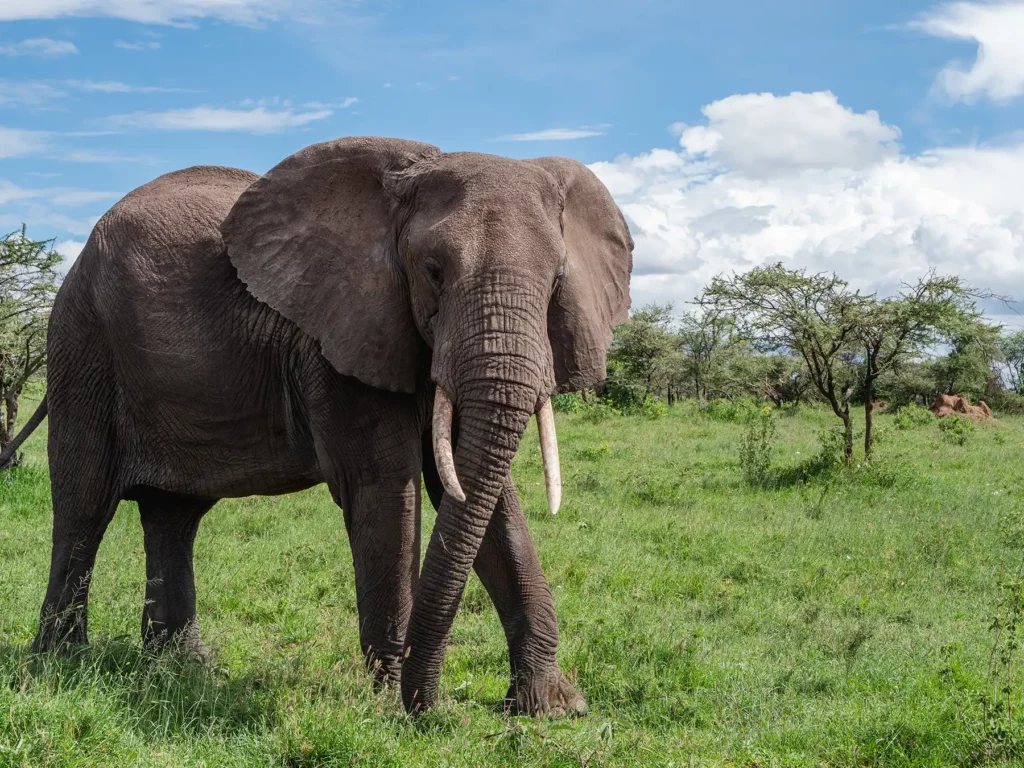
Kenya and Tanzania offer some of the best safari destinations on the planet, so I can’t blame you for wanting to visit both! From the endless landscapes to diverse wildlife, I’ve had exceptional experiences in each.
That said, I also know how exhausting it can be, especially if you’re keen to make the most of a 10-day trip and want to fit a lot in. For that reason, I’ve carefully put this itinerary together to avoid long travel times and other mistakes, so you don’t have to repeat the ones I’ve made! After all, I’m sure you’d rather be out on safari than stuck on a long, bumpy drive. (Although sometimes that’s unavoidable!)
This itinerary is also perfect for getting close to each country’s varied wildlife. I’ll certainly never forget watching cheetahs hunting in Kenya’s Amboseli, or seeing three leopards in one day in the Serengeti and not to mention more lions than I could count!
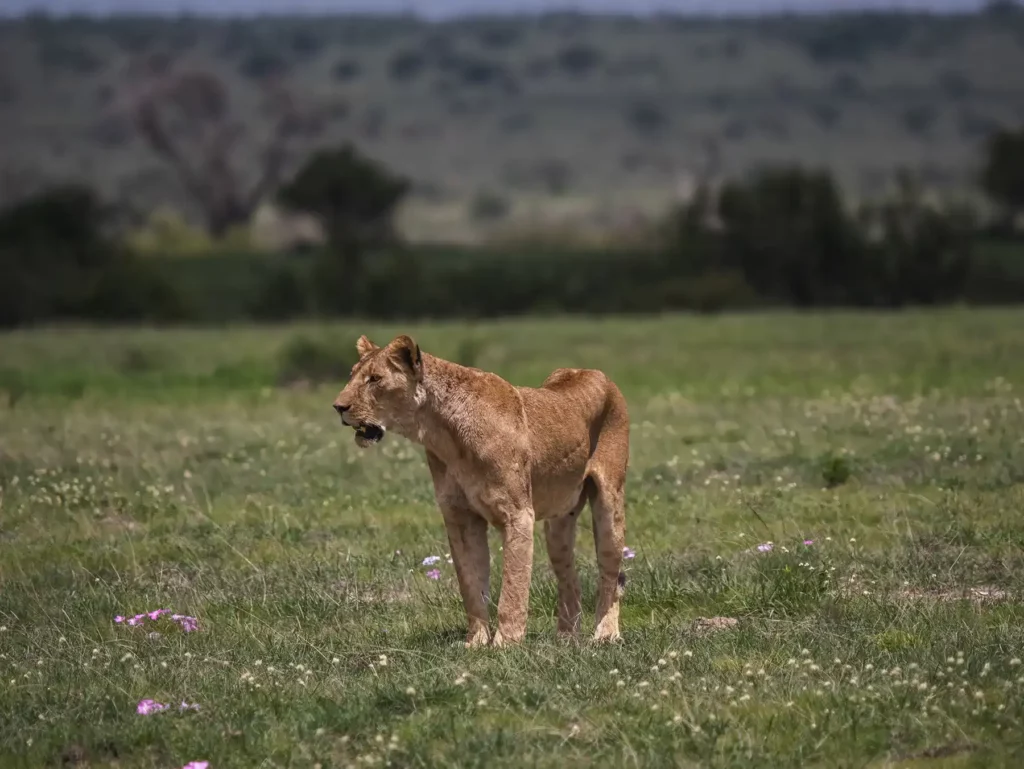
If you haven’t quite decided on how many days you’ll be visiting, you can also view my 2-week Tanzania and Kenya itinerary. If you have the time, I’d personally recommend extending your trip to 2-weeks over 10 days as it allows you to explore at a much more relaxed pace.
I also have separate 10-day itineraries for both Tanzania and Kenya if you feel like exploring either country more in-depth.
In this guide, you’ll find a carefully curated 10-day Kenya and Tanzania safari itinerary. Within this post, you can find everything you need to know about planning your trip, from the expected costs, when to visit and how to book a tour operator to advice on making the most of your holiday once you arrive. Read on to start planning the trip of a lifetime!
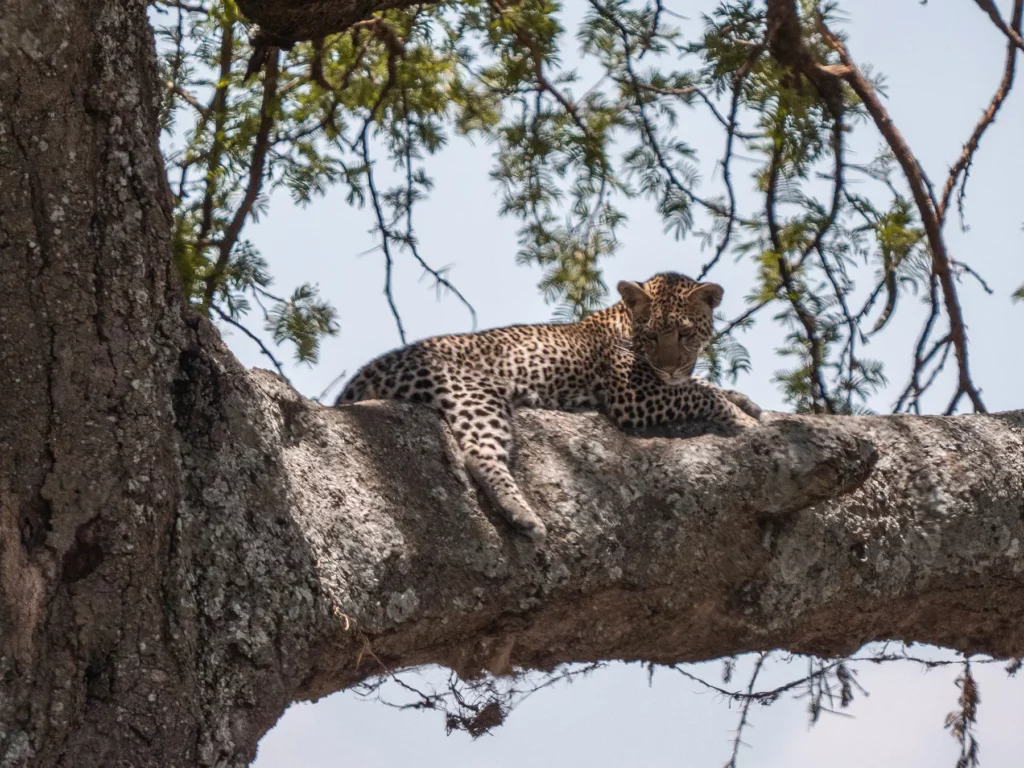
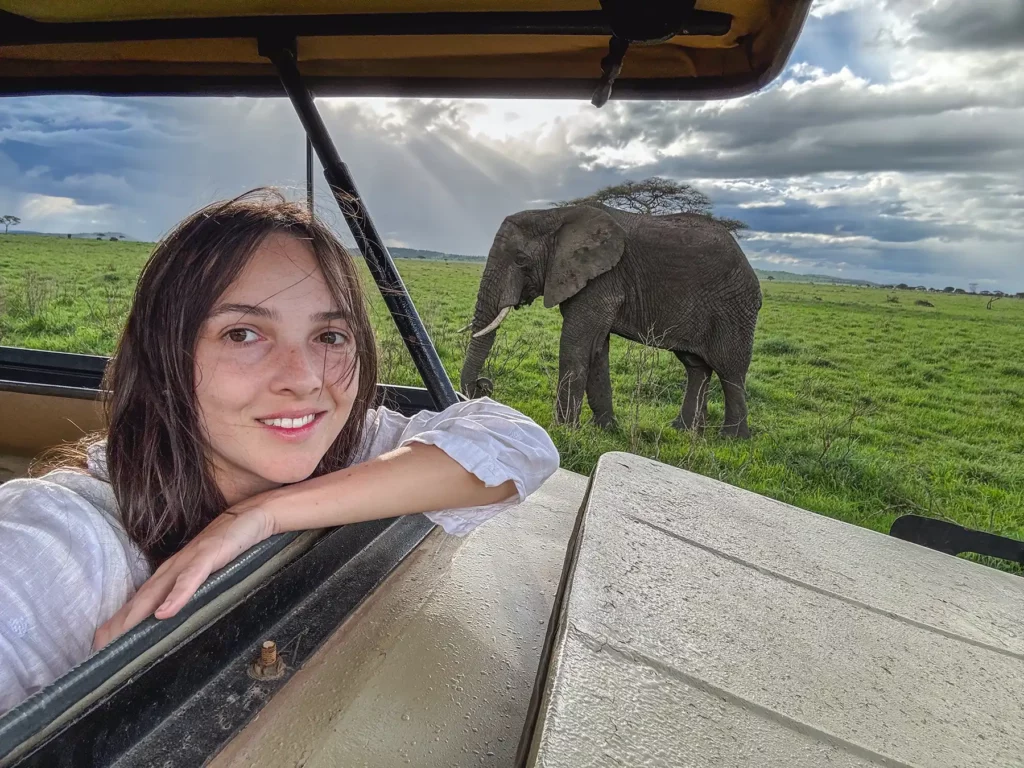
Embark on the Safari of Your Dreams
Save time and ensure an incredible safari experience by getting quotes from my recommended local safari companies
I’m here to make booking your perfect safari quick, easy and risk-free.
Join the rapidly growing tribe of over 1,000 travellers who’ve booked their dream safari using my insider tips and recommendations.

It takes under 60 seconds to fill out the form and in under 48 hours you will receive multiple, no-obligation proposals from my favourite local tour operators with glowing online reviews.
Get your free no-obligation safari quotes and my top safari tips and recommendations
10-Day Kenya & Tanzania Itinerary Map
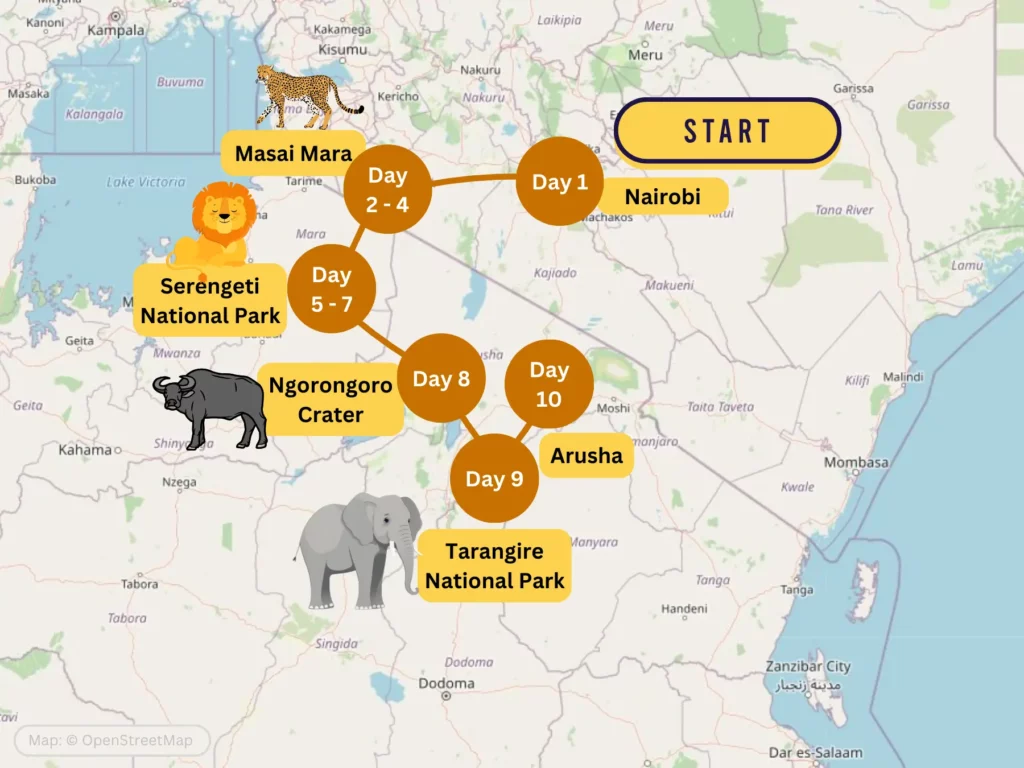
In this Guide
- Why Go on Safari in Kenya and Tanzania?
- How to Book Your Kenya and Tanzania Safari
- How Much Does a Kenya and Tanzania Safari Cost?
- Best Time to Visit Kenya and Tanzania
- How Long to Spend in Kenya and Tanzania
- Kenya and Tanzania Safari Logistics
- Kenya and Tanzania Safari Itinerary Overview
- Day by Day Breakdown
- Final Thoughts

Why Go on Safari in Kenya and Tanzania?
Kenya and Tanzania are both fantastic countries to go on safari and are considered among the best wildlife destinations in Africa – especially for first-time safari-goers due to the ease of access and well-established safari trail.
Among their top parks include Kenya’s Maasai Mara, renowned for its superb viewing of big cats, while Tanzania’s Serengeti is perhaps Africa’s most famous national park – and for good reason.
Both countries host all of the Big Five (lions, elephants, leopards, rhinos, and buffaloes), alongside an array of other species that likely feature on your list of must-sees, including cheetahs, giraffes, zebras, hyenas, and numerous others.
Below is a map I put together of Kenya and Tanzania showing their safari highlights. You can pinch the image to zoom or follow the links to access my bigger map of Tanzania or map of Kenya.
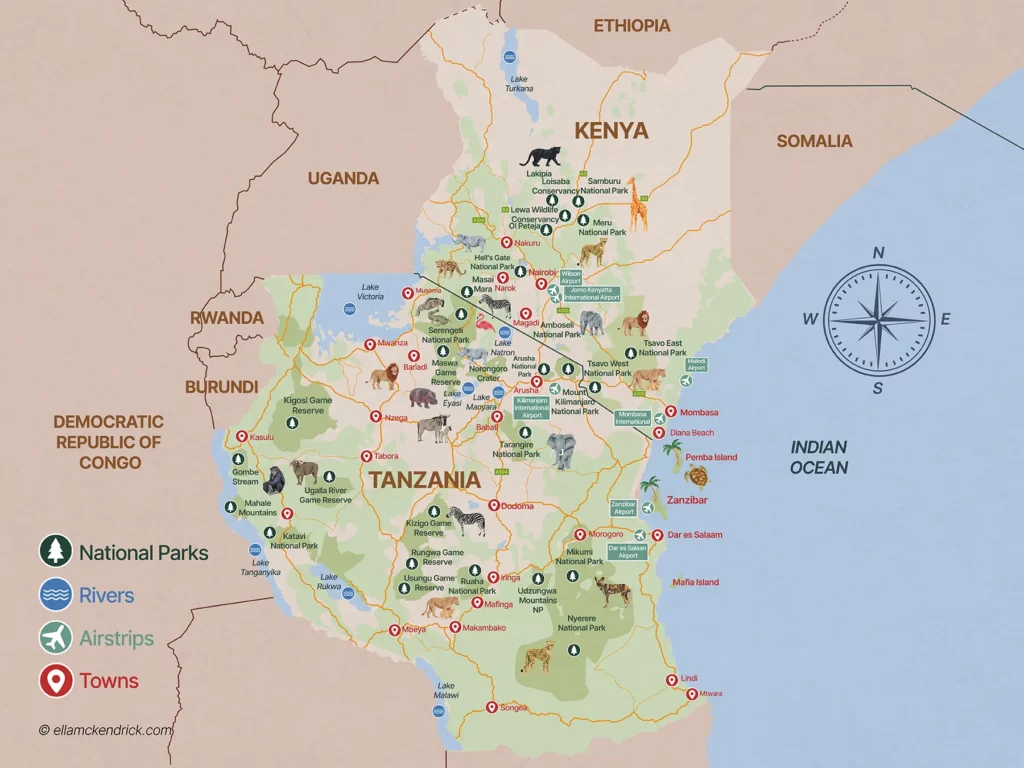
Besides the wildlife, the countries’ landscapes are equally breathtaking. Tanzania is home to Mount Kilimanjaro, Africa’s tallest mountain, whereas Kenya offers Mount Kenya, the continent’s second-highest peak. The Great Rift Valley, traversing both countries, ensures the presence of many remarkable lakes that burst with aquatic life.
Due to the fact these countries border one another (Kenya in the north with its premier parks being in the south of the country and Tanzania in the south with its flagship parks being in the north of the country), it’s easy to combine the countries into a single trip and see the highlights of each.
Numerous airlines allow you to book multi-city tickets, allowing arrivals in one location and departures from another, without a significant price increase compared to return flights to the same destination.
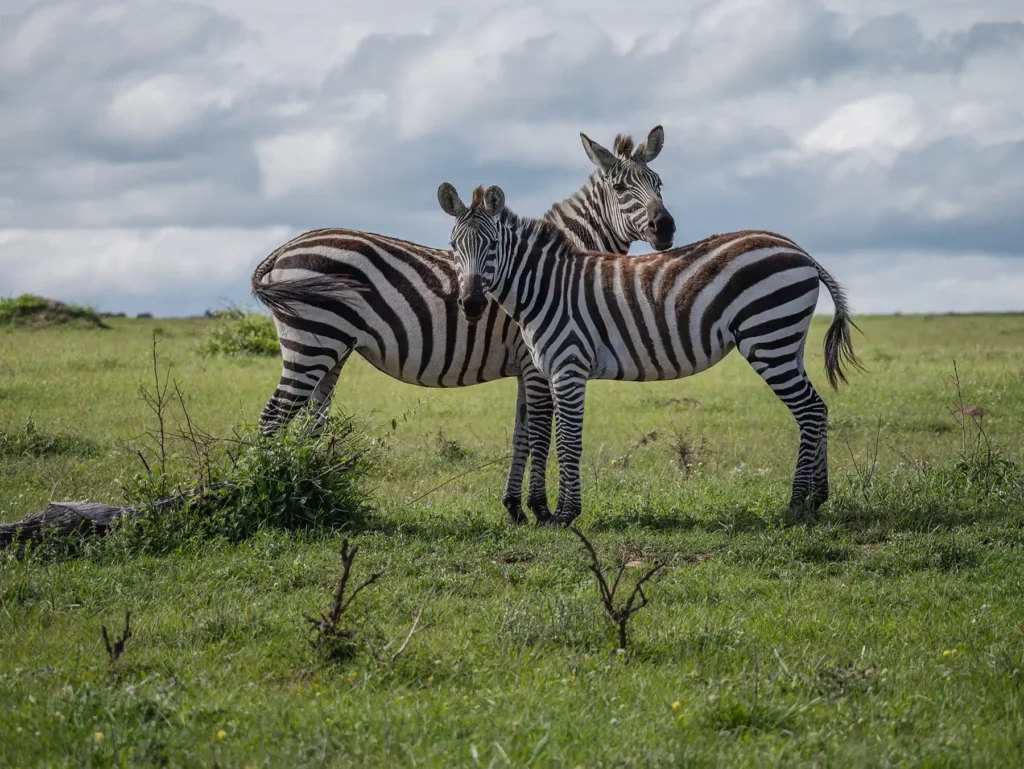
How to Book your Kenya and Tanzania Safari
There are several ways to book your Tanzania and Kenya safari and the method you choose can have a big impact on the safari costs as well as your experience.
I’ll go through the pros and cons of each method below to help you decide how to book your perfect safari.
You can jump to the booking options using the links below.
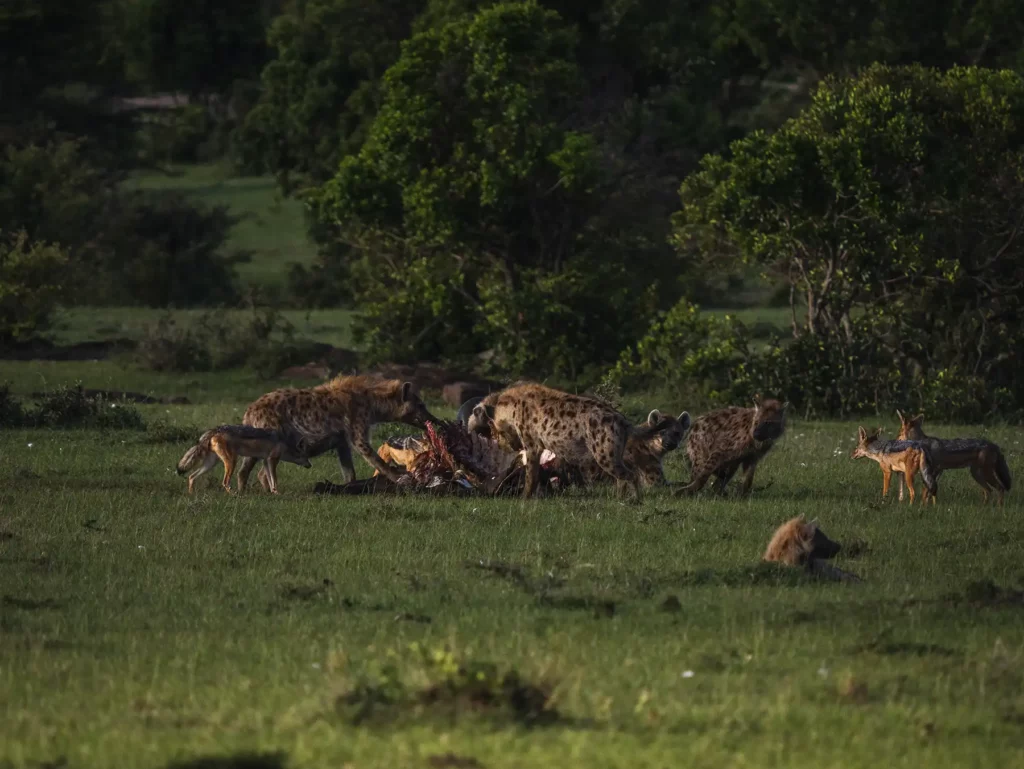
Option 1: Self-Drive Safari
Going on a self-drive safari in Kenya and Tanzania seems like a great idea if you want to be in charge of your trip. But when you look into it, you might find that saving money on a self-drive isn’t as easy as it sounds.
First off, the big costs such as park entrance fees are the same regardless of whether you drive yourself or go on a tour. These fees can be pretty high, especially for famous spots like the Maasai Mara or the Ngorongoro Crater.
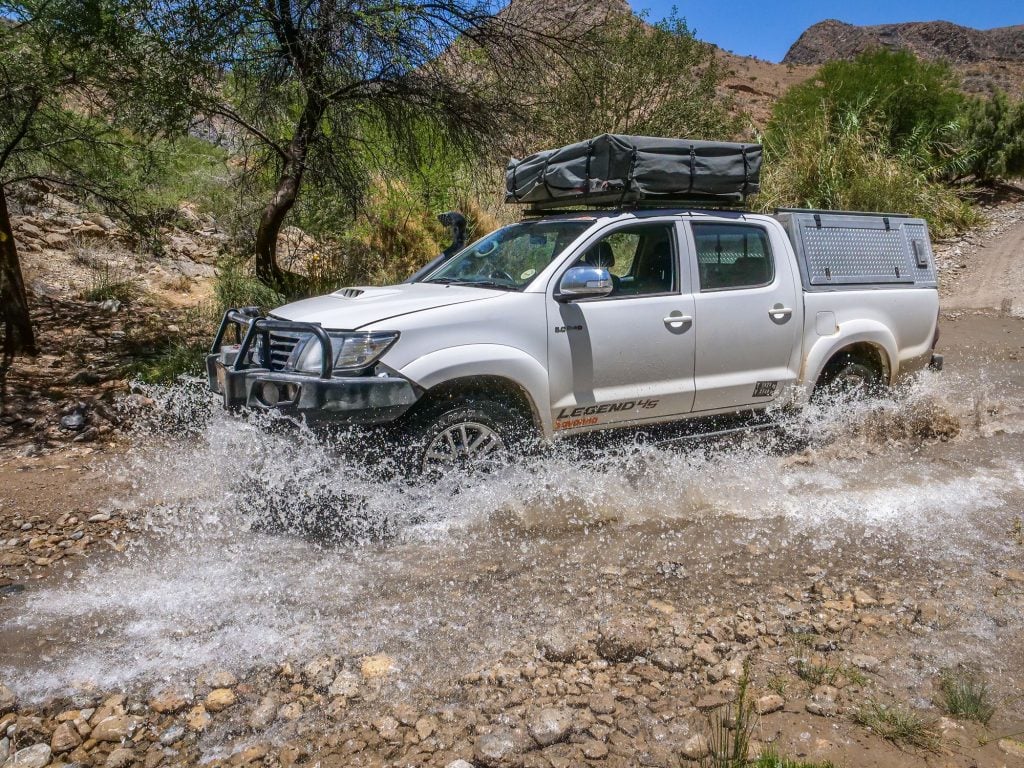
Also, you won’t get a better deal on hotels and lodges if you book them on your own as tour operators can actually get better deals on hotels. I managed to book a safari at a lodge through a tour operator that was significantly cheaper than it would have been had I booked the safari through the lodge directly.
Meanwhile, a good-quality 4×4 vehicle rental— a necessity for travelling the terrains of Kenya and Tanzania’s national parks—comes with its own set of daily costs, which are often pretty steep. The requirements to enter Tanzania’s parks are quite strict and regular 4×4 vehicles are often turned down, as I saw first-hand when a couple were denied entry to the Serengeti in a regular 4×4 SUV. A Land Cruiser is really a must and renting these is often around $150 – $200 per day.
Another thing to think about is that if you rent a car in Kenya and drive to Tanzania (or the other way around), the police often stop vehicles just because your car has foreign plates which, whilst not the end of the world, is an annoying bit of extra drama on your trip.
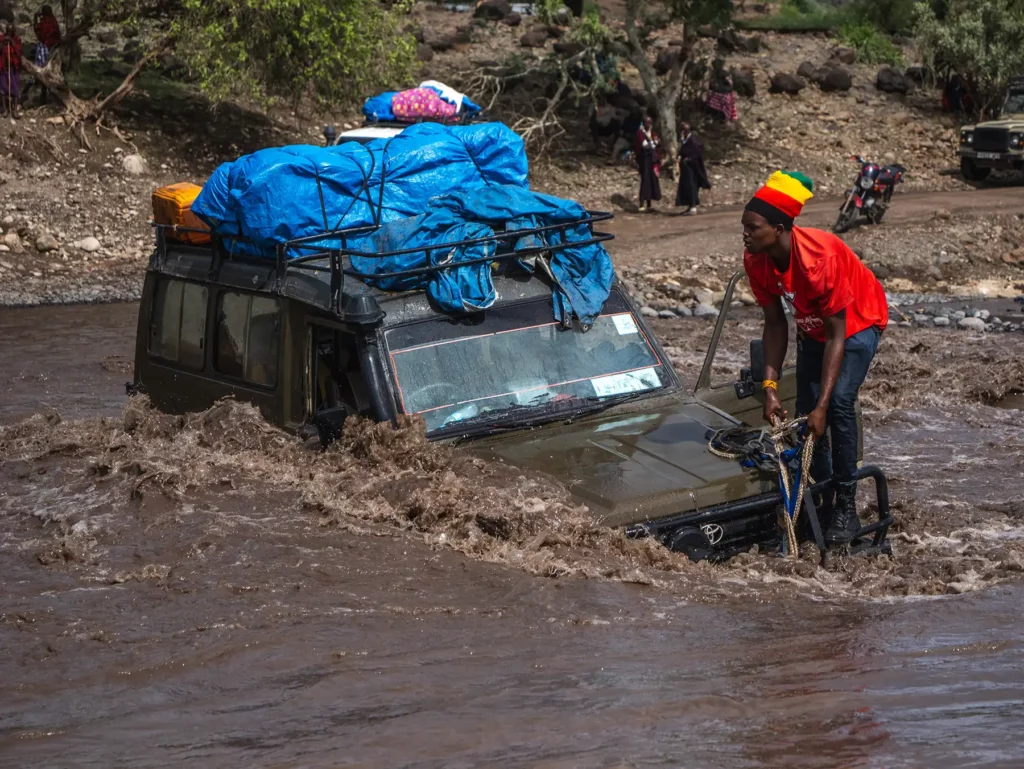
But most of all, while not having to pay for a guide might seem like a way to save money, you’ll likely miss out on seeing a lot of wildlife that only local guides can spot. Not to mention all the organisational things you’ll have to spend time doing yourself, such as getting permits.
Although I loved the independence of self-driving when I was in Namibia, even I would find driving around East Africa’s huge parks tough. Without a guide, you are unlikely to see as many animals, and you could get lost, especially in tricky places like the Masai Mara, thanks to a severe lack of road signs (gulp!).
So, all in all, the hassle is unlikely to be worth it just to make a small saving.
How to Book a DIY Self-Drive Tanzania Safari
- Option 1: Comparison sites which provide multiple quotes from verified suppliers such as Safaris By Ella. Make sure to write you want to self drive in the notes when requesting a quote. (This is a hybrid approach where you’ll drive yourself but they will arrange everything)
- Option 2: Research and book all elements of the trip yourself using Google and online travel agents.
Join the rapidly growing tribe of over 1,000 travellers who’ve booked their dream safari using my insider tips and recommendations. Get your free quotes and my top tips and recommendations now.

Option 2: Local Tour Operator
Booking with a local tour operator for your safari in Kenya and Tanzania can often be just as affordable as planning a self-drive adventure, especially the group options.
Choosing a local tour operator over an international travel agency also saves you money. International agencies mark up the price significantly and then hand off the actual trip planning to local firms. So, you end up with a similar experience but at a higher cost.
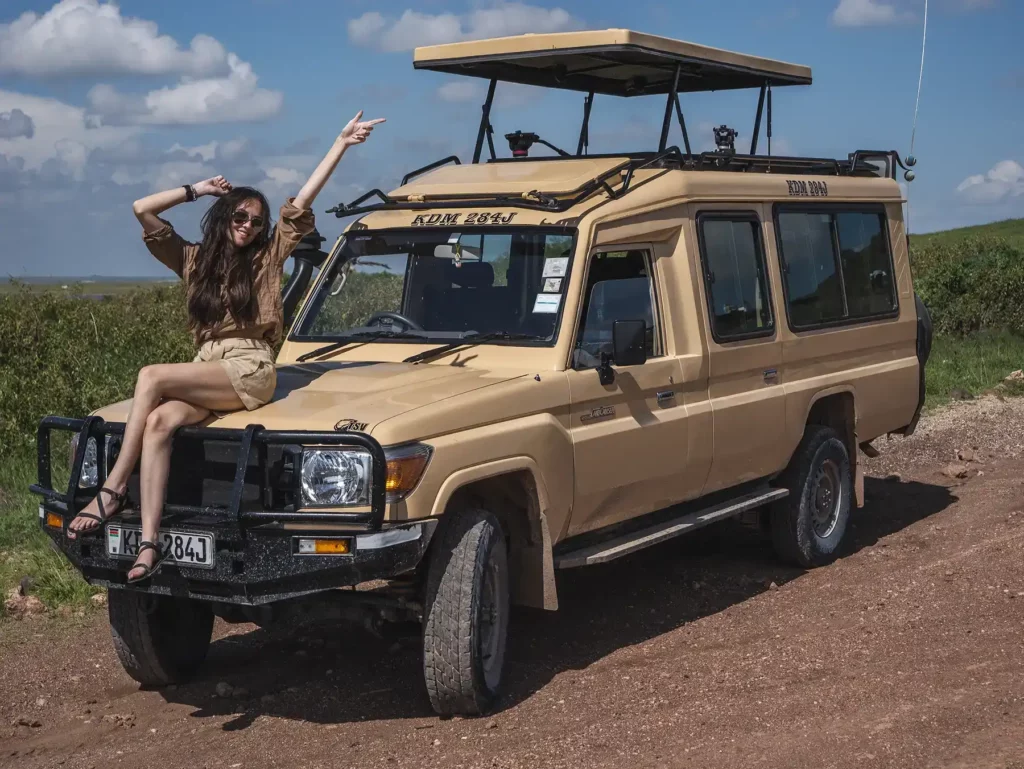
Local operators handle everything for you – from hotel bookings and park entry fees to providing full board, vehicles, fuel, and an experienced driver-guide. The only extra costs on top of the safari package are your international flights, visa fees, tips, drinks other than water, and any souvenirs you might want to bring home.
When booking safaris, you usually have the choice between private and group tours. If it’s within your budget, I always suggest a private safari for more flexibility and a tailored experience, unless you’re travelling solo and keen to meet new people. Group tours often don’t offer the same level of choice regarding accommodation, park visits, or safari timings. Plus, the best guides are typically assigned to private tours.
The safari experience can vary significantly depending on which local operator you choose. Reading reviews is crucial to finding a reliable operator. Look for feedback on independent sites like Google Reviews (rather than the positive reviews they showcase on their websites).
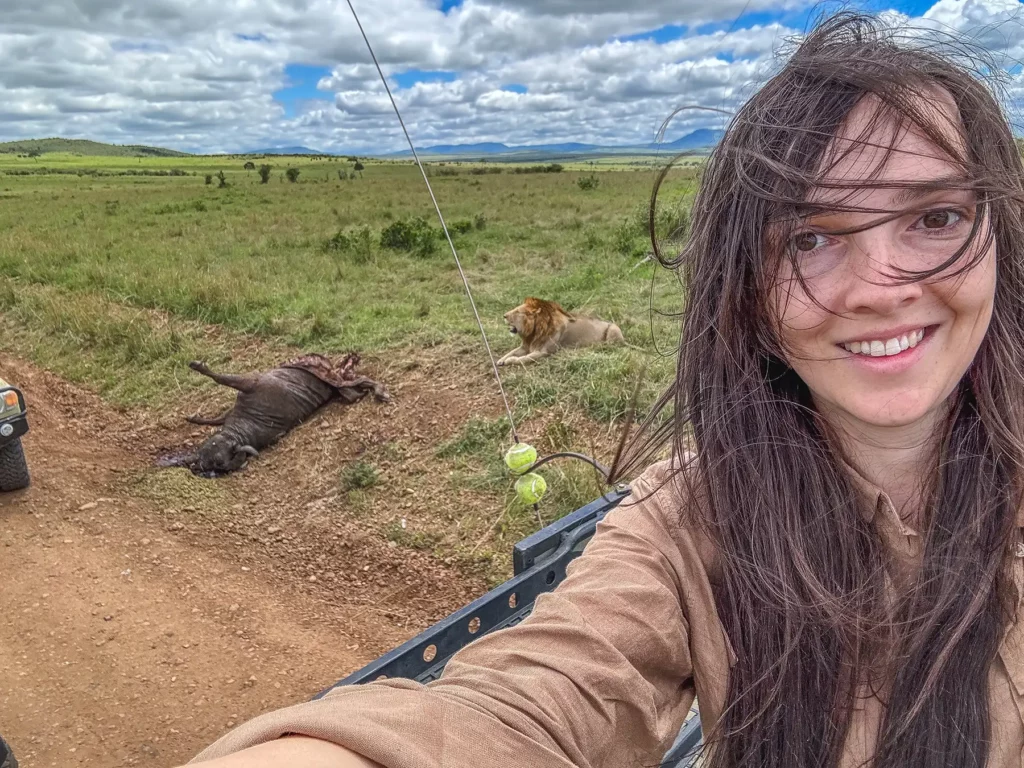
My own safari experiences have varied widely from one operator to another. Some have been incredibly accommodating and flexible, while others have been less willing to adjust plans, even for simple requests like starting the safari a bit earlier.
How to Book with the Best Local Safari Companies
- Comparison sites which provide multiple quotes from verified suppliers such as Safaris By Ella
Join the rapidly growing tribe of over 1,000 travellers who’ve booked their dream safari using my insider tips and recommendations.
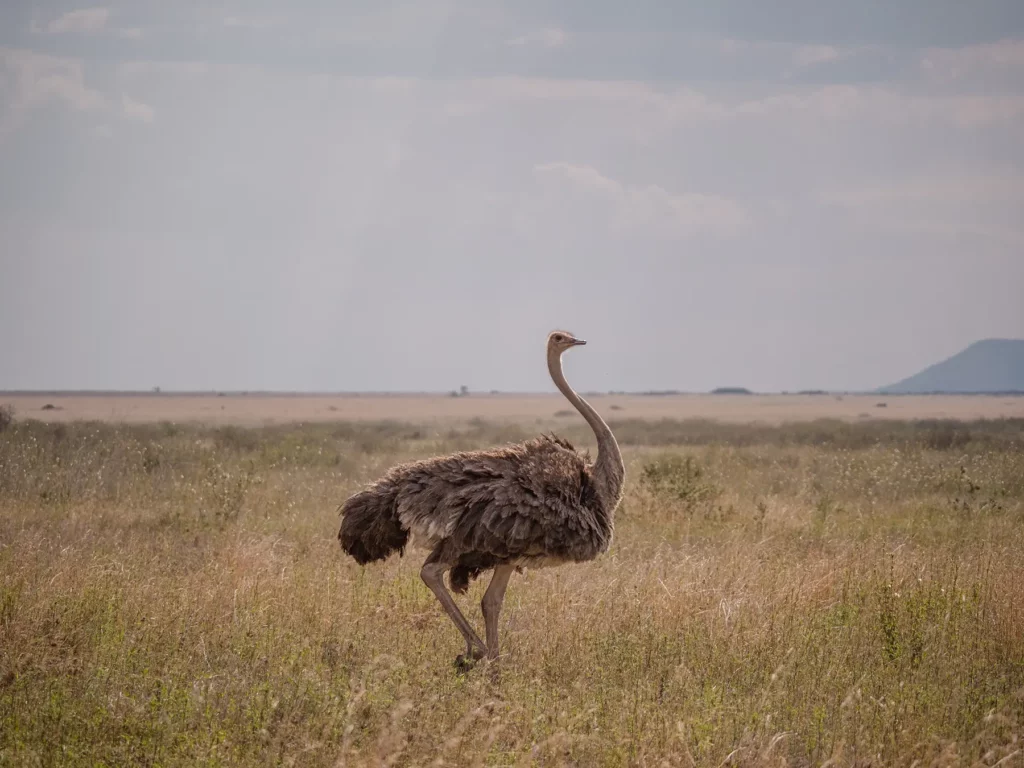
Option 3: Overseas Travel Agents
Choosing an overseas travel agent might seem like the easiest way to book your safari, mainly because they can handle both your international flights and the safari itself. However, this convenience comes at a significant cost, often making it the priciest option.
Despite this, the actual safari experience they offer isn’t better. They typically delegate the safari arrangements to local operators in Kenya and Tanzania, which means you end up with an experience that’s virtually identical to what you’d get by booking directly with local companies.
However, overseas travel agents tend to mark up profits significantly. So, while opting for an overseas travel agent may simplify the booking process by including flights, it also escalates the overall cost considerably.
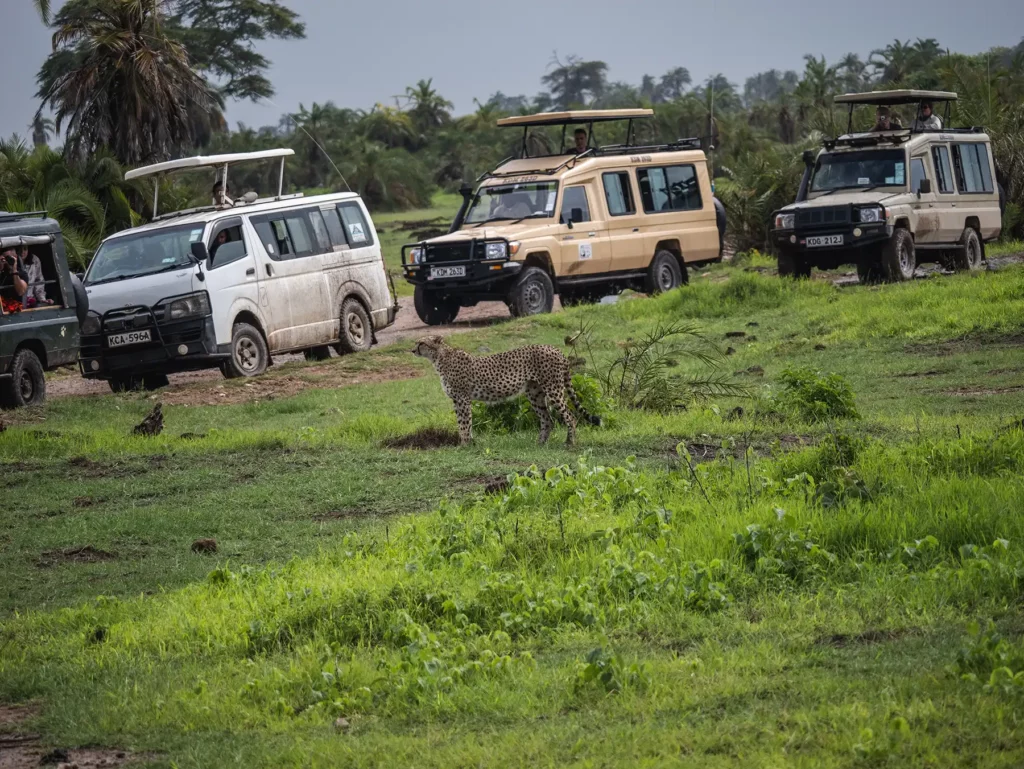
A benefit for international travel agents is that In the UK you will be covered by Package Travel Regulations which can provide some assistance if they go bust before your trip. If they book international flights as part of your package, you will be covered by the ATOL scheme.
In America there are schemes such as the Airline Passenger Protection Act and the Federal Aviation Administration’s consumer protection rules which apply when booking through a local travel agent in the US.
There are, however, steps you can take to protect against these risks yourself when booking directly with local suppliers.
My tips would be using your credit or debit card to make payment for the deposit as these typically offer purchase protection (In the UK it’s called Section 75). Purchasing good travel insurance with travel interruption protection or similar. Opt for a recommended local safari company as they will usually allow you to make balance payments near to the trip date which further minimises any risk.
How to Book Your Safari with an International Travel Agent / Safari Company
- Comparison sites which provide multiple quotes from verified suppliers such as Safaris By Ella. When you select a luxury budget on the quote request, you will receive a quote from my recommended International safari company as well as my recommended local companies for comparison.
Join the rapidly growing tribe of over 1,000 travellers who’ve booked their dream safari using my insider tips and recommendations.
Option 4: Hotel-Provided Safaris
Many lodges and tented camps offer their own safari experiences, which can be ideal if you’re planning to stay in one place for a while. However, this might not suit you if you’re looking to explore different areas, as you won’t have a personal vehicle.
Flying is often the easiest way to get from one hotel to another, especially when they’re in different parks. Many parks have their own airstrips, and hotels near or inside the national parks usually can arrange to pick you up and drop you off, though they might charge extra for this service. But, be prepared: these flights aren’t cheap, costing over $100 per person, and sometimes as much as $500 per person for certain routes.
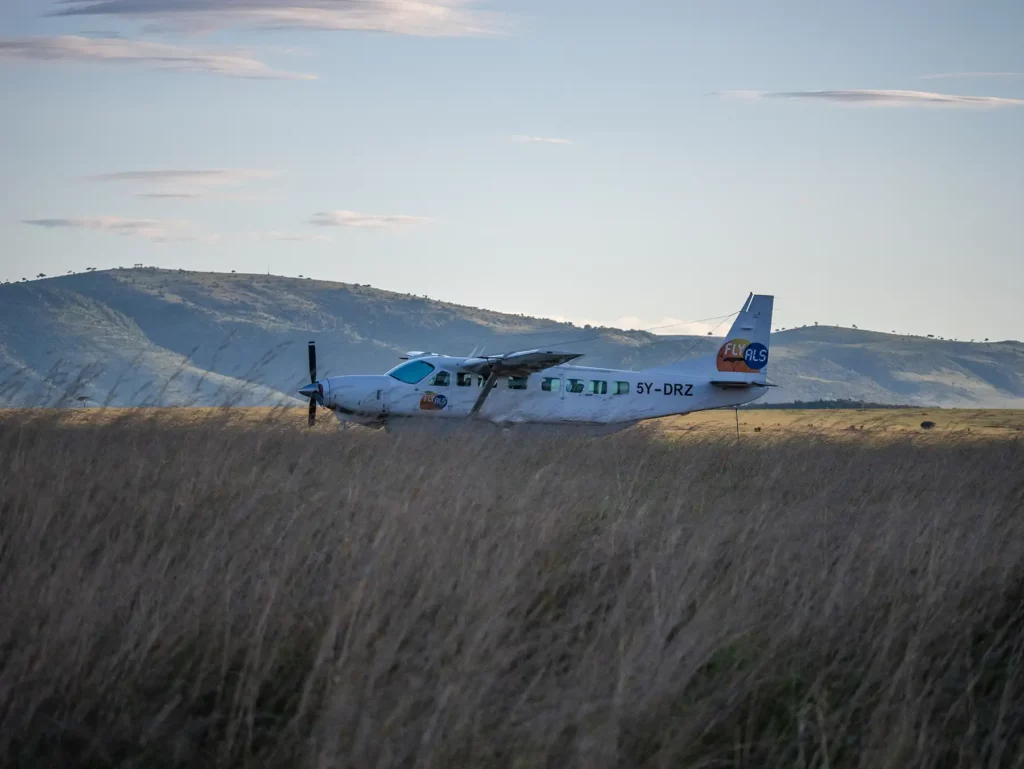
If your journey includes going from the Masai Mara to the Serengeti, or any two parks across the border, you’ll likely need to take two flights. The first flight will bring you to an international airport where you can go through immigration, and the second will take you to your final destination. You might even need to travel by road between two airports to catch your connecting flight.
Another point to bear in mind is that safaris organised by lodges often aren’t private and you’ll be sharing the vehicle with other lodge guests. This takes away flexibility in terms of what time you go out, how long you stay at each sighting and also which sightings to prioritise.
Whilst not the most budget-friendly option, hotel-provided safaris can be great if you’re looking to explore one area for a prolonged period and take things slow.
How to Book a Hotel-Provided Safari
- Option 1: My recommended tour operators on Safaris By Ella can arrange hotels and air or road transport to and from the hotels. If you opt for the more cost-effective road transport, since they have driven you to the hotel, you might find it cheaper to use the safari company for safaris rather than using the hotel-provided safaris.
- Option 2: Check with your chosen accommodation whether they provide this service and the booking requirements.
So, what is the best way to book a safari?
I recommend booking your Kenya and Tanzania safari with a local tour company. I believe it offers the most value for money, provides the next overall experience and at the same time helps to support local businesses in East Africa.
This option is also cheaper than booking via a travel agency, as these basically just act as a middleman, which hikes up the prices without offering additional perks. It’s just as simple to book directly, but make sure you read reviews to work out which company sounds best for you.
Planning a trip to East Africa can seem really tough, especially if it’s your first time. But a big plus of using a local safari company is that they take care of almost everything for you: where you’ll stay, entrance fees for parks, your meals, the car you’ll travel in, a skilled driver-guide, drinks in the car, and more.
Save Time and Ensure an Incredible Safari Experience
Get quotes from the local safari companies I use to organise my own trips.
You’ll join the rapidly growing tribe of over 1,000 travellers who’ve booked their dream safari using my insider tips and recommendations.

How Much Does a Kenya and Tanzania Safari Cost?
Although costs vary, prices for a private Kenya and Tanzania safari using a local tour operator typically begin from around $280 per person per day.
If you’re on a tighter budget, group safaris cut costs to around $190 per person per day. These tours usually include basic accommodation including camping.
The below chart shows typical safari costs based on your budget and preferred comfort level, but please note these are based on booking through a local operator and will cost significantly more if you book through an overseas travel agent.
| Comfort Level | Price Per Person Per Day | 7 Days | 10 Days |
| Shared Budget | From $140 PP | From $970 | From $1,400 PP |
| Private Budget | From $300 PP | From $2100 PP | From $3,000 PP |
| Private Midrange | From $400 PP | From $2,800 PP | From $4,000 PP |
| Private Luxury | From $650 PP | From $4,550 PP | From $6,500 PP |
| Private Luxury + | From $1,000 PP | From $7,000 PP | From $10,000 PP |
Please note that the starting from costs above are for booking through a local company. Prices will be higher if you book through an overseas company or travel agent.
Below are typical prices for Kenya and Tanzania.
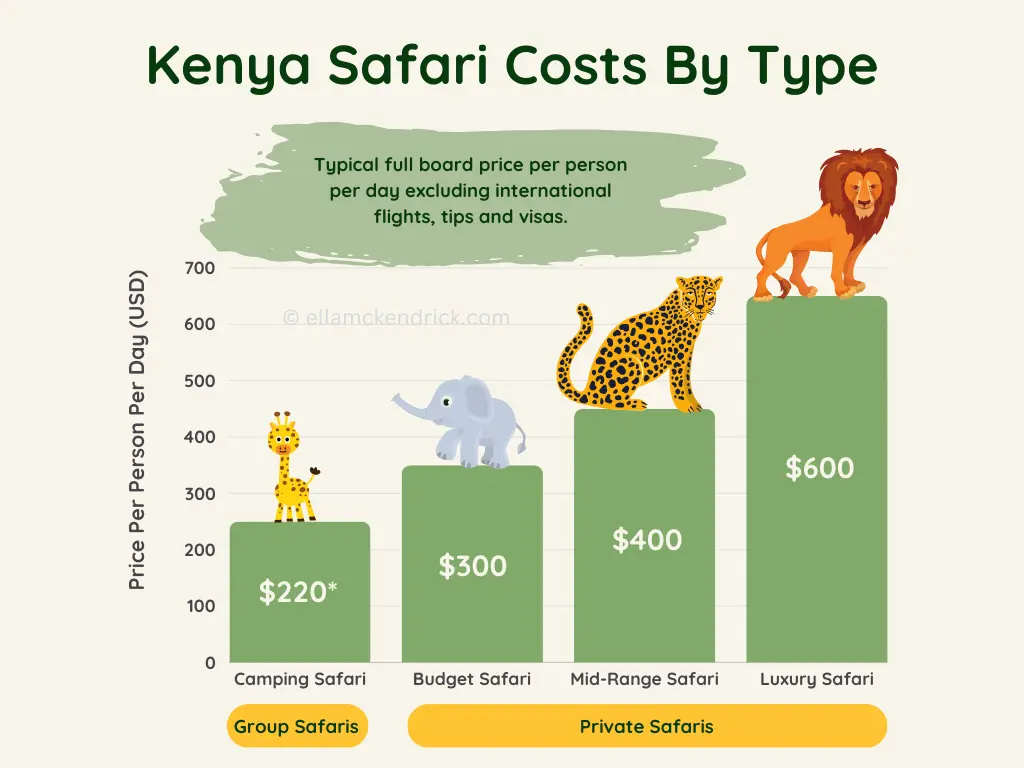
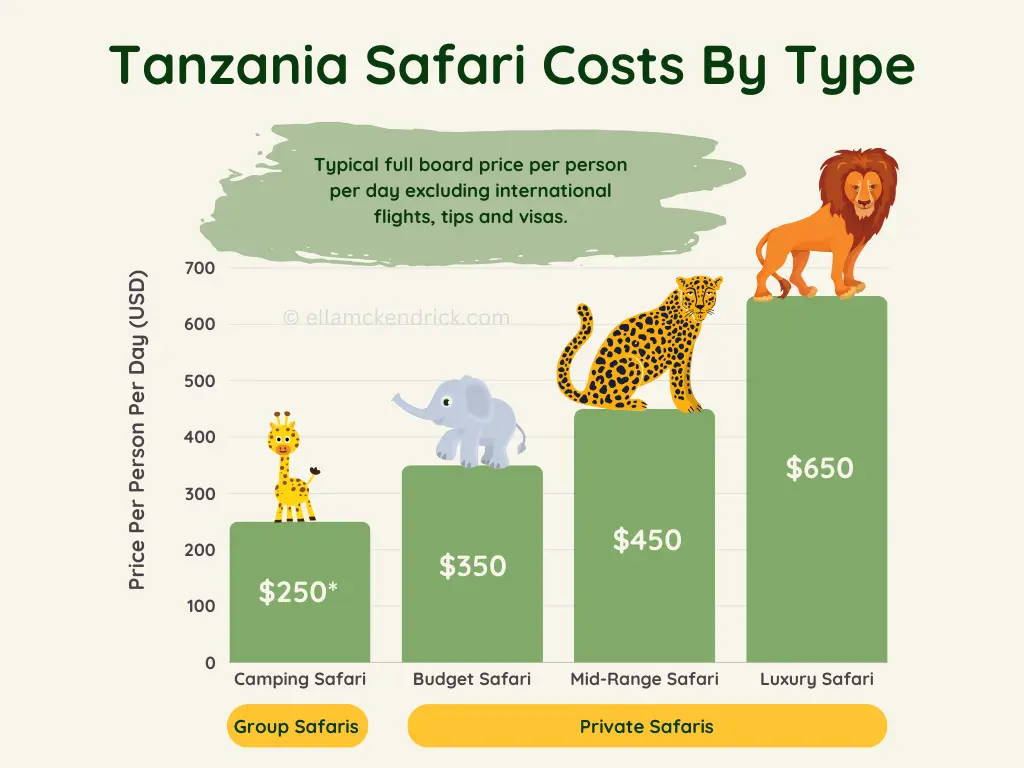
Kenya and Tanzania Safari Cost Breakdown
Kenya safari costs and Tanzania safari costs are very similar. Whilst Kenya was once regarded as a cheaper safari destination, recent increases in park fees have now made both countries pretty much identical when it comes to safari costs.
The most expensive part of an East African safari is the park fees. For example, it costs $200 + 18% tax per person to enter the Maasai Mara in peak season for a 12 hour period. Slightly cheaper parks like Amboseli are still $100 +18% tax per person per day.

Park fees are similar in Tanzania with it costing $70 +18% tax per person per day to enter the Serengeti plus an additional $60 + 18% tax concession fee to spend the night in the park (staying outside the park isn’t an option with the Serengeti). Total cost per person to stay in Serengeti for a 24 hour period is $153.40 and that’s just in park fees.
The next biggest cost on your safari will be your lodges and tented camps. Even budget camps in Serengeti cost around $150 per person per night (this price excludes the nightly concession fee). Prices for camps bordering the Masai Mara in Kenya are similar. However, lodges and camps are typically full board so this price does include all your meals and soft drinks.
Below I’ve included a chart which breaks down where the money goes for a safari of two people.

Factors Affecting Kenya and Tanzania Safari Cost
There are many factors that dedicate your overall safari cost.
Perhaps the biggest factor is your accommodation comfort level. Whilst a budget tented camp can cost between $50 – $150 per person depending on location, mid-range camps can cost $200 – $400 per person per night and luxury lodges can cost anywhere from $400 per person all the way up to $3,000 per person per night.
Another huge factor is the time of year that you choose to visit. For example, park fees for peak season in the Maasai Mara (July to December) are $200 + 18% tax per person. This is double the fees in low season (January to June) which are $100 + 18% tax per person. Lodges and tented camps are also more expensive in peak season and can reduce their prices by up to 30% in less busy times of year.
Your mode of transportation for game drives will also have an impact on your safari cost. In Kenya you have several options, the cheapest being a minivan. Land Cruisers typically cost $50 more per day than minivans and you can pay even more to have a photographic Land Cruiser with dropped sides. Minivans aren’t on offer in Tanzania with Land Cruisers being the only option.
The final key factor that can affect your cost is how you choose to journey between parks. The cheapest and most popular way to travel is by road in the same vehicle that you’ll be using for your game drives. This doesn’t cost you any extra on top of your safari as you’re already paying per day for your vehicle. However, you may wish to fly between parks which saves you a lot of time. These flights typically cost around $300 per person per flight although some can be as much as $500 per person per flight.
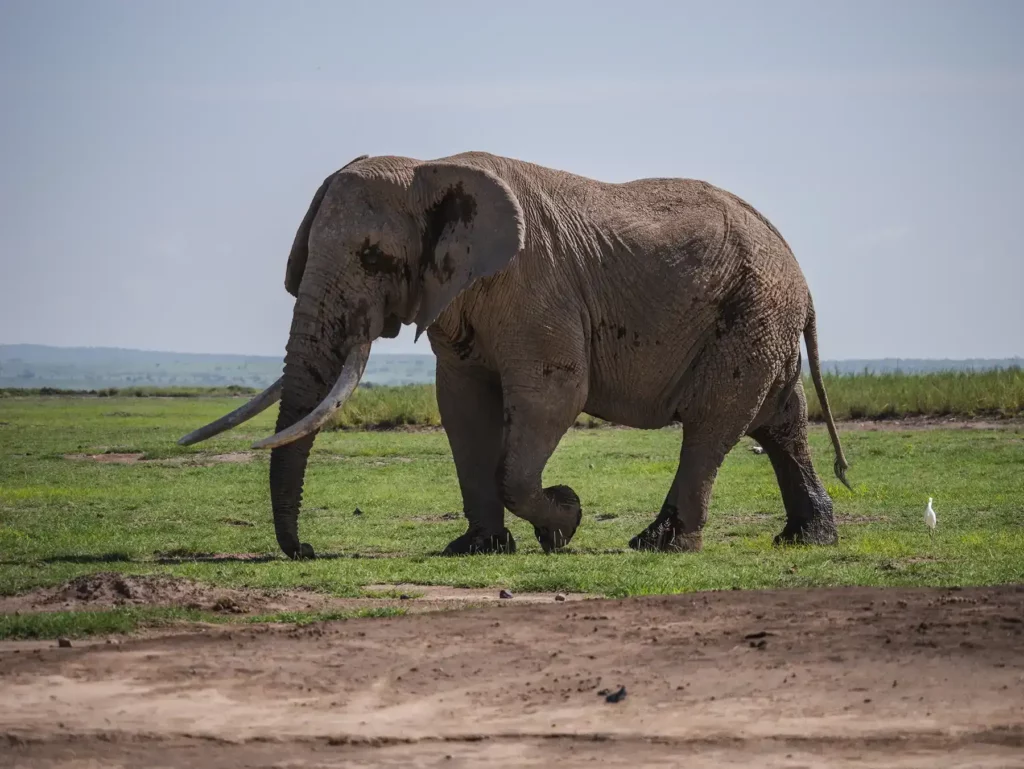
Best time to Visit Kenya and Tanzania
Although Kenya and Tanzania can be visited at any time of the year, the weather can influence your trip and what animals you might see.
I’ve created the visual guide below to give you a quick reference to what to expect in each month. This guide is for Tanzania, however, Kenya being next door is very similar.
I’ve ranked each month of the year for safari in Tanzania as Excellent, Good, OK, or Poor, based on typical game viewing and weather conditions.
If you want to dig deeper, the chart below shows what you can expect in each month in Tanzania in terms of cost, weather, wildlife and hiking Kilimanjaro.

For more information take a look at my ultimate guide on the Best Time to Visit Tanzania.
There are two main dry seasons in East Africa. The longer dry season, from June to mid-October, is often seen as the best time for a visit. The weather is comfortably warm, there’s hardly any rain, and less greenery means it’s easier to spot wildlife because they tend to gather around waterholes.
Then there’s a shorter dry season from mid-December to late February. This period is the warmest, though it can still get a bit of rain. This season is special because the landscape is green and full, perfect for photography. While lush vegetation sometimes makes animals harder to spot, the area’s rich wildlife means there’s always plenty to see, including lots of newborn animals, which is a real treat.
The rainy season from March to May is often less popular for visits since it can get very wet. However, rain patterns have been changing, and sometimes the expected rains don’t come at all.
A brief rainy season occurs from mid-October to mid-December when you might see some evening showers, but generally, it stays dry and sunny. Recently however, rain patterns during this period have become less predictable, with heavy rains causing flooding in some years.
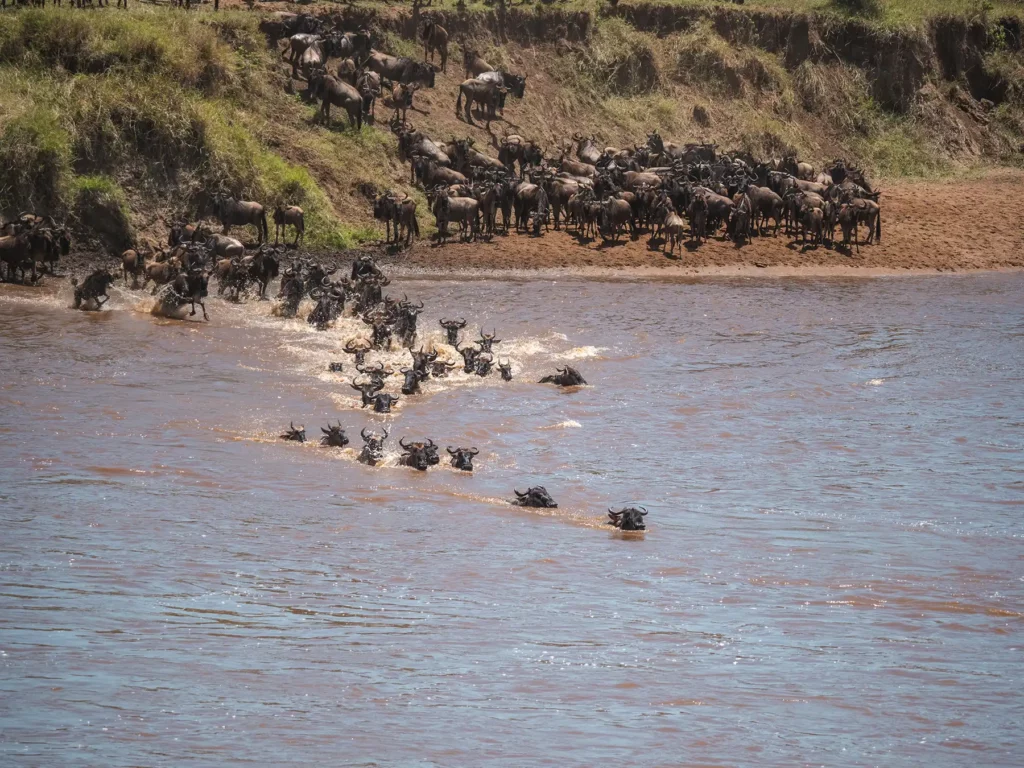
Timing your visit to catch the highlights of great wildebeest migration is highly recommended if you can, as this is considered one of the best wildlife experiences on the planet. The most popular time to see the great migration is from mid-July to mid-September. This is when you can witness the dramatic crossings over the Mara River, a real-life survival drama as wildebeest tackle the swift currents and crocodiles.
Another fantastic time to visit is mid -January and late February in southern Serengeti when thousands of wildebeest calves are born each day. It’s amazing to watch the newborns take their first steps, and this period also attracts a lot of predators, making it an exciting time for wildlife viewing as you may well witness a kill.
You can learn more by reading my guides on the best time to visit Tanzania and the best time to visit Kenya.

How Long to Spend in Kenya and Tanzania
Ideally, I’d recommend spending at least around 5 days in Kenya and another 5 days in Tanzania if time allows. This gives you enough time to visit the key safari destinations in each country and a really good chance of seeing a wide variety of wildlife.
For those with a few more days to play with, a 14 day itinerary will give you a chance to visit the dreamy beaches of Zanzibar at the end of your trip.
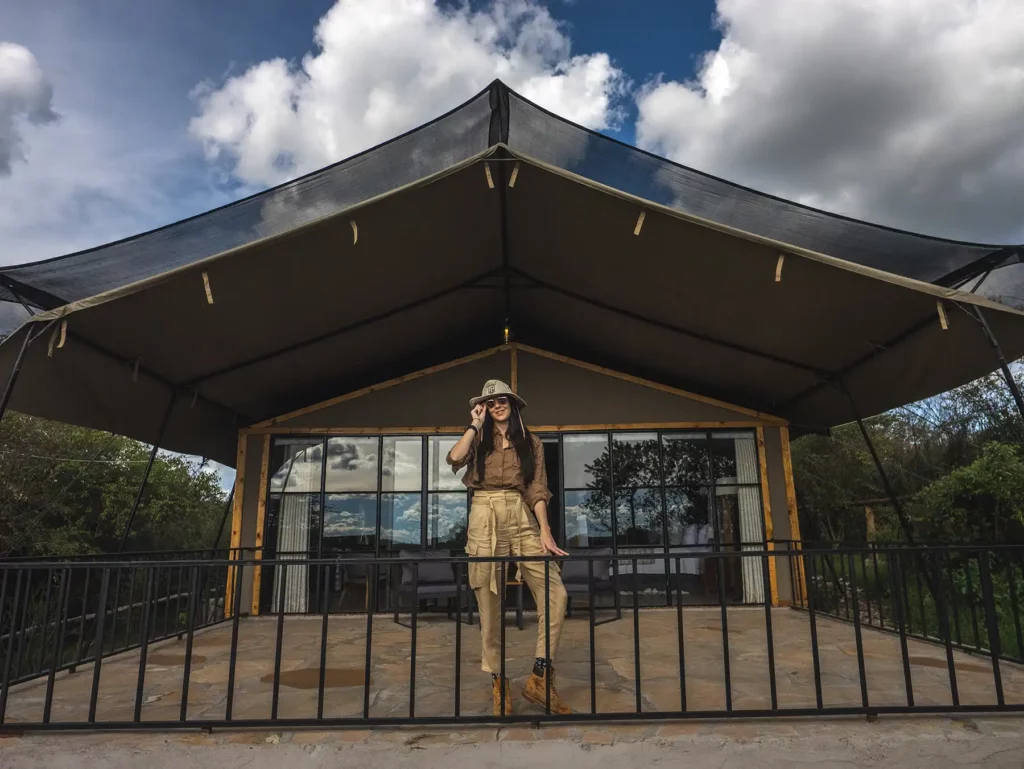
Kenya and Tanzania Safari Logistics
When booking your safari with a local tour operator, many of the points here will already be covered, but it’s a good idea to familiarise yourself with the below sections so you are up to date with what might be needed on your part.
Border Crossings
There’s not much you need to sort out yourself for crossing borders between Kenya and Tanzania, besides getting your visa and making sure your paperwork is in order. But, it’s good to know how these crossings work to help everything run smoothly.
You can cross between the countries either through land borders or at airports. Usually, crossing at airports is quicker because there are fewer people. Still, I’ve found crossing land borders between Kenya and Tanzania to be very straightforward and positive.
If you’re flying, say, from the Masai Mara in Kenya to the Serengeti in Tanzania, you’ll need to take two flights and a 45-minute car ride between them to cross at a land border, as there’s no direct international airport connection in this region.
For land crossings, keep a few things in mind:
- Safari operators from Kenya can’t operate in Tanzania, and the same goes the other way. This rule helps local businesses thrive. So, when you reach the border, you’ll switch to a new vehicle and driver from the other country.
- At the border, you’ll need your passport, visa, and yellow fever certificate ready for the officials. You might also be asked to have your luggage scanned, but it’s best to wait for your guide’s advice on this.
- My experience with crossing land borders into Tanzania and back into Kenya was incredibly smooth—no queues and the process took about 10 minutes. However, I travelled during the quieter short rainy season. During the busier period from June to September, you might encounter longer waits.
Your safari will be handled by separate companies in Kenya and Tanzania, but don’t worry—these companies usually work closely with partners across the border. So, although you book with one company, they’ll coordinate with their partner for the part of your trip in the other country.

Visas
For tourism in Tanzania, visitors from many countries, including the UK, US, Canada, Australia, and many European nations, are required to obtain a visa.
Most travellers will need a single-entry visa, costing $50 per person. However, American citizens must opt for a multiple-entry visa, which is priced at $100 per person.
Tanzania allows you to apply for visas upon arrival, as well as the option to secure them ahead of time through their e-visa system.
I always recommend sorting your visa before you travel, to avoid any delays or problems when you land.
You can apply for your Tanzanian e-visa online.
It’s wise to apply for your e-visa around 1 to 2 months before your trip since processing can take a few weeks.
On the other hand, from 2024, Kenya has introduced visa-free entry, meaning you no longer need a visa to visit. However, you will need to apply online for an Electronic Travel Authorisation (eTA) before your trip. There are a few exceptions to this rule, and you can find a comprehensive list of them.

Vaccinations
Kenya is listed as a country where Yellow Fever can occur, so you’ll need to be vaccinated against it. In contrast, Tanzania is considered to have a lower risk of Yellow Fever. If you’re moving between Kenya and Tanzania, you’ll need to show your Yellow Fever vaccination certificate. Without it, you won’t be allowed entry.
While other vaccinations aren’t compulsory, they are strongly advised, including for Hepatitis A, Hepatitis B, and Typhoid, among others. You can view a complete list of suggested vaccinations.
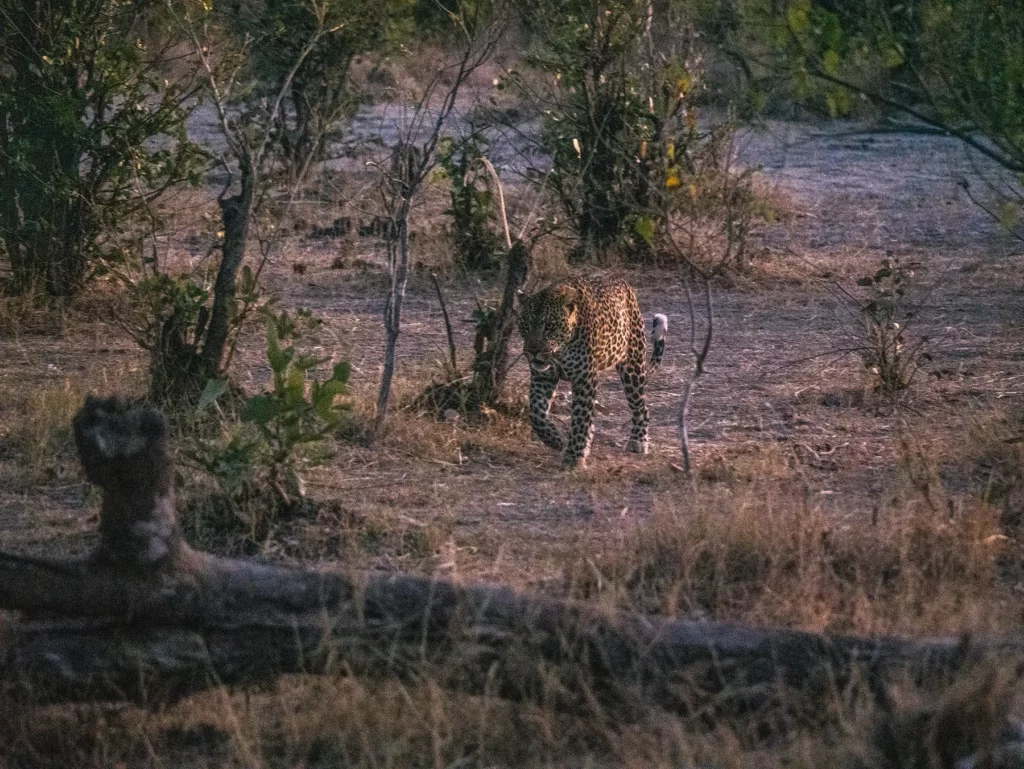
Medications
Alongside antimalarial medication, it’s always a good idea to put together a travel health kit. This should include any prescription medicines you’re on, as well as over-the-counter remedies for common travel issues such as diarrhoea, pain, and allergies.
Make sure your prescription containers are clearly marked, and if you can, bring along a note from your doctor explaining what each medication is for and why you’re taking it. And of course, don’t forget to pack insect repellent, sunscreen, and – knowing how easily I find myself in scrapes – a basic first aid kit too.
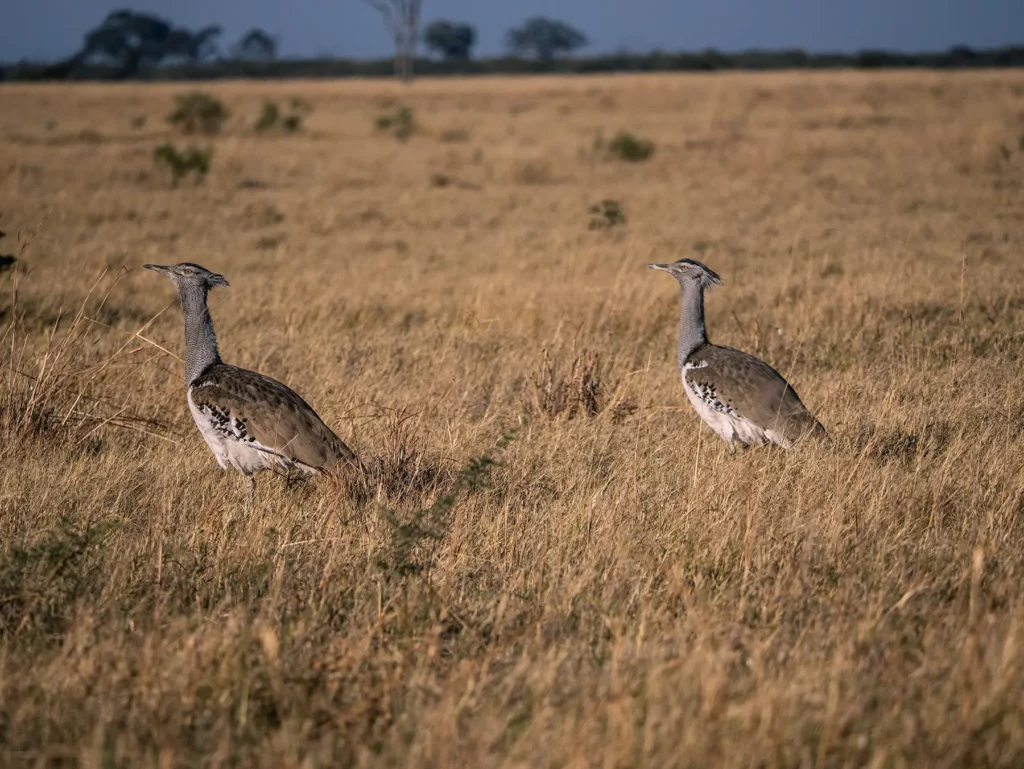
Kenya and Tanzania Safari Overview
Having enjoyed many trips in both Kenya and Tanzania, I have a lot of experience in both countries and have also soaked up lots of local advice along the way.
With all this in mind, I’ve carefully crafted this 10-day Kenya and Tanzania itinerary, to ensure you can truly make the most of each day here.
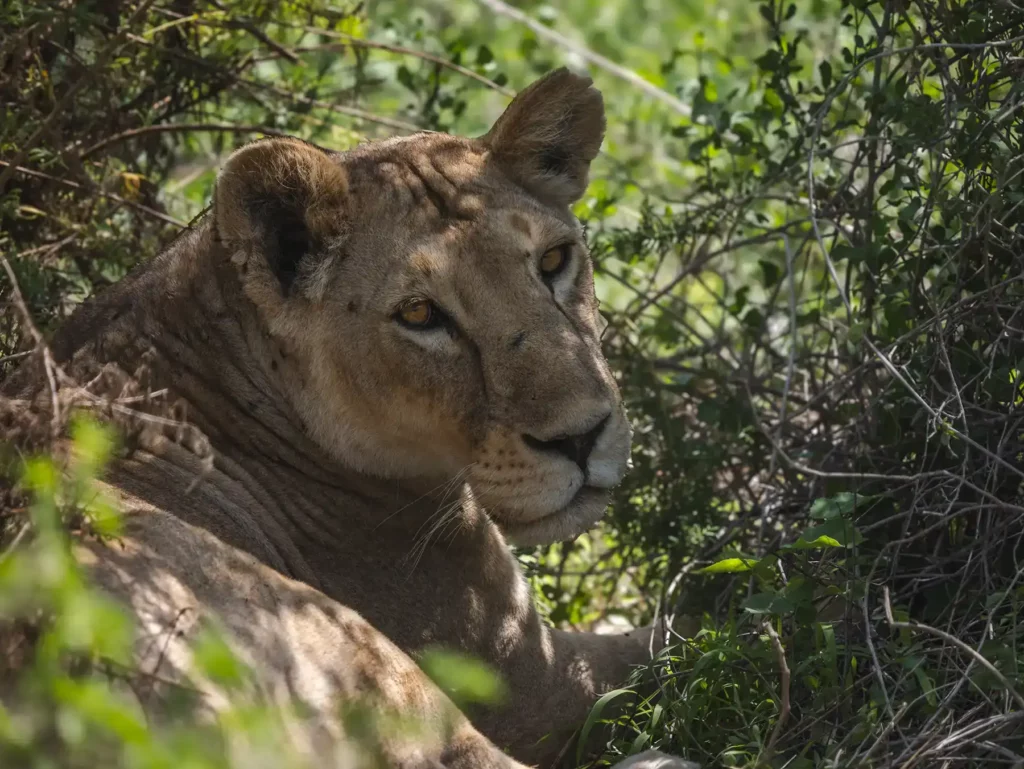
This safari route makes sure you’ll see the best safari parks in each country, while also considering logistical elements (such as travel time!) to ensure you spend more time viewing animals than you do on the road – although admittedly it’s impossible to cut out travel time completely, no matter how you travel!
This trip begins in bustling Nairobi. In the following days, you’ll go on a safari adventure through the Masai Mara and Serengeti, see huge groups of animals travel across the savannah, You’ll picnic overlooking the Tarangire River, meet traditional tribes, awe at the Ngorongoro Crater, and end your trip in Arusha under the shadow of Mount Meru.
Here is a map of the itinerary route.

Day by Day Breakdown of the Ultimate 10-Day Kenya and Tanzania Safari Itinerary
Here’s what you can expect to experience on what I can truly call my ultimate 10-Day Kenya and Tanzania safari itinerary.
Click any of the days below to jump to my full notes on that day.

Day 1: Nairobi
Today’s drive time: dependent on what activities you choose to do on this day
Nairobi is a bustling modern city where nature is only ever a stone’s throw away, giving you a sneak peek of what’s to come in Kenya.
If your plane gets in early, you might have time to check out some cool places in the city. You could visit the Nairobi National Museum to learn about the area’s history or walk around Karura Forest for a gentle start to your trip.
If you land later in the day, there’s still lots to do. Evening is a great time to try some local food (Nairobi has an excellent food scene!) or check out the vibrant nightlife. However, no one will blame you if you prefer to relax at your hotel to prepare for the days ahead!
Whether you spend your first day exploring or just relaxing and enjoying the vibe, it’s the beginning of a trip you’ll always remember.

About Nairobi
Known as the ‘Green City in the Sun’, Nairobi is special because it has Nairobi National Park right in the city, where you can see animals like lions, giraffes, and rhinos – a very unique experience mixing wildlife with city buildings in the background.
If you’re interested in Kenya’s stories and past, places like the Nairobi National Museum and the Karen Blixen Museum are also great to visit.
Getting around in Nairobi is pretty easy. You can use taxis, matatus (which are like small buses), Uber, or even motorbike taxis if you’re feeling brave. Most people here speak English and Swahili, so it’s usually easy to talk to locals. Just like in any big city, it’s important to be careful, especially at night, and keep your things safe.
For food lovers, Nairobi is exciting because the thriving food scene offers a great mix of local restaurants where you can try traditional dishes like roasted meat and maize alongside top-notch international eateries.

Where to Stay in Nairobi
In Nairobi, choosing the right area to stay in can make your visit even better.
For first-timers, areas like Westlands and Karen are my top picks. Westlands is bustling with shops, restaurants, and nightlife, making it perfect for those looking to experience Nairobi’s urban side. Karen, on the other hand, offers a more relaxed vibe with its green spaces and is closer to attractions like the Giraffe Centre and the Nairobi National Park.
When it comes to accommodation, you’ve got plenty of choices, from hotels to Airbnb options.
Hotels in Nairobi range from luxury to budget-friendly and often provide strong security, which can be reassuring for travellers. Hotels also offer amenities like pools, restaurants, and sometimes even safari bookings. The downside? Hotels can be pricier and might not give you that ‘home away from home’ feeling.
Airbnb, meanwhile, can offer a more personal touch. You might find yourself staying in a residential area, giving you a slice of local life. These accommodations can be more budget-friendly and give you the freedom to cook your own meals.
However, it’s important to research the area you’re booking in, as the level of security and accessibility to public transport can vary. Airbnb stays might not offer the same level of services and amenities as hotels, and safety in the evenings should be top of your priority list.

Things to Do in Nairobi
There is plenty to keep you busy in Nairobi. Kenya’s capital is a busy city where skyscrapers and wildlife parks sit side by side.
Some travellers will prefer to relax after their flight but for those who want to get out and see what Nairobi has to offer here are some of my favourite ways to spend a day in Nairobi.
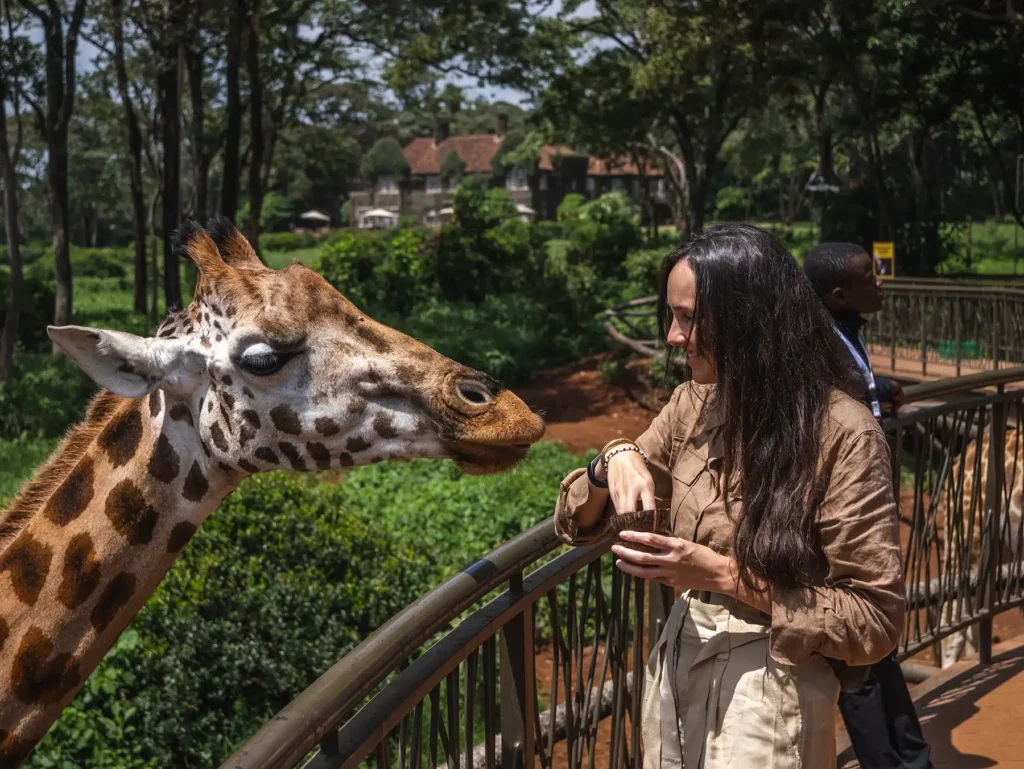
The Giraffe Centre
Visiting the Giraffe Centre in Nairobi is an experience not to be missed, especially if you’re keen on getting up close and personal with these gentle giants.
Located in the leafy suburb of Karen, the centre offers a unique opportunity to feed and even kiss a giraffe from a raised platform, providing a memorable encounter and fantastic photo opportunities. It’s not just about the fun; the centre plays a crucial role in the conservation of the endangered Rothschild’s giraffe, aiming to educate visitors about wildlife conservation.
The entrance fee is quite reasonable ($20 per person), and your visit contributes to the conservation efforts. Whether you’re an animal lover or just looking for a unique experience in Nairobi, the Giraffe Centre promises an unforgettable day out for visitors of all ages.

2. Nairobi National Park
Exploring Nairobi National Park is an absolute must-do when you’re in Kenya’s capital.
It’s remarkable, really – a vast expanse of wilderness right on the doorstep of a bustling city, where you can spot lions, rhinos, giraffes, and more against the unlikely backdrop of city skyscrapers.
The park offers morning and afternoon game drives, allowing you to experience the thrill of a safari without needing to venture far from Nairobi. Besides the wildlife, the park is also home to the Ivory Burning Site Monument, a powerful reminder of the ongoing battle against poaching.

3. David Sheldrick Elephant Orphanage
Attached to Nairobi National Park is one of Nairobi’s most famous attractions – the David Sheldrick Elephant Orphanage.
The orphanage gives you the opportunity to see young elephants that have been rescued, enjoying their time as they eat, play, and hang out with their caregivers. This place works hard to help these baby elephants get better after being rescued, with the hope of returning them to the wild someday.
Whilst I am generally sceptical about sanctuaries and orphanages across the world as many aren’t as ethical as they make out to be, this one is genuinely doing some wonderful things for conservation.
When you visit, you’ll learn about the dangers these elephants face, and what’s being done to help them. It’s not just a fun visit; it also helps you understand how important it is to look after these amazing animals. It’s as educational as it is heartwarming.
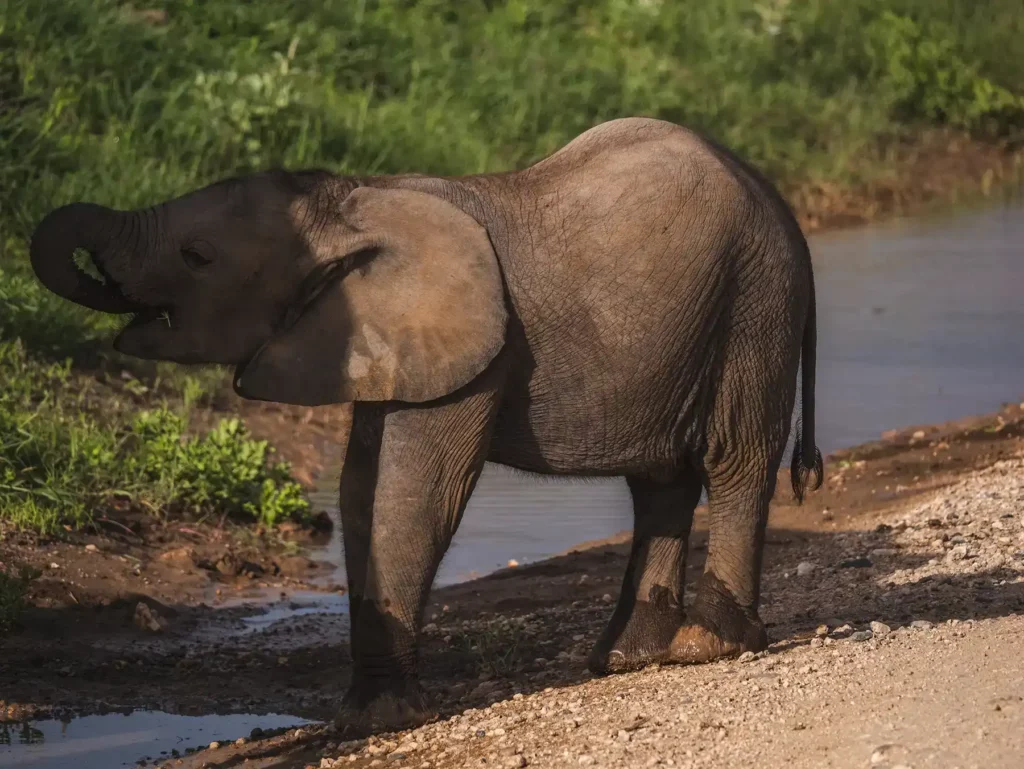
4. Eat at One of Nairobi’s Delicious Restaurants
In Nairobi, eating out is a big part of the fun, with loads of spots for any taste. If you’re up for trying some local food, you’ve got to check out Carnivore Restaurant. It’s famous for its barbecue, where you can try all sorts of game meats in a chilled-out, outdoor vibe.
For seafood lovers, Tamarind Nairobi is a more fancy spot that won’t disappoint, serving up some seriously tasty dishes. Whereas if you’re looking for somewhere to grab a quick bite or a coffee, Java House is the place, offering everything from local dishes to familiar favourites in a comfy setting.
My absolutely favourite place to eat in Nairobi is Talisman Restaurant in Karen which serves a range of dishes inspired by countries around the world from North Africa to East Asia.

Tips for Visiting Nairobi
There are a few tips to make your trip to Nairobi even smoother.
First up, always carry some cash in Kenyan shillings, as not everywhere accepts cards, especially if you’re venturing into smaller shops or markets. Remember to bargain – it’s expected, and part of the fun!
Getting around can be a bit tricky, so using reputable taxi services or ride-hailing apps like Uber is recommended for safety and convenience. For those keen on exploring the city’s vibrant street life, always stay aware of your surroundings and keep your belongings secure, as you would in any large city.
Nairobi’s weather can be unpredictable, so dressing in layers is wise. Evenings can get cool, even after a hot day. And, of course, don’t forget to stay hydrated and protect yourself from the sun with hats and sunscreen.
Take the chance to enjoy the local cuisine. From street food to high-end restaurants, Nairobi’s food scene is diverse. Try local dishes like ugali and nyama choma for an authentic taste of Kenyan culture.
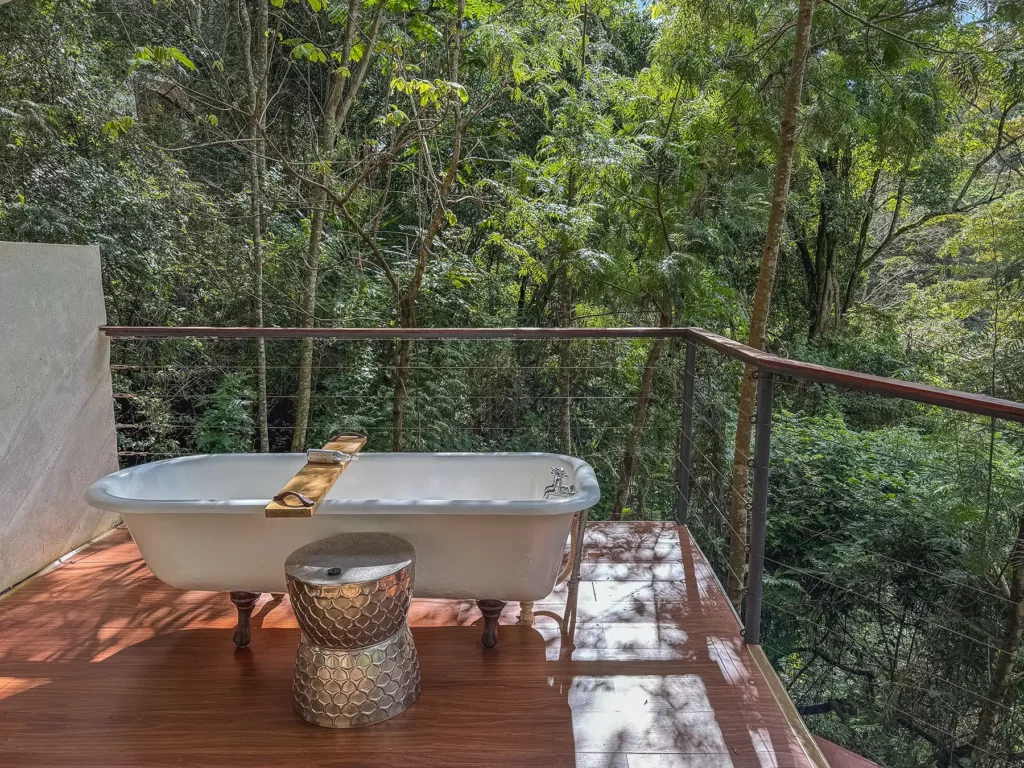
My Experience Visiting Nairobi
From the moment I arrived in Nairobi, I loved Kenya. So don’t be alarmed by the bustling streets – the locals here are incredibly friendly and I’ve always felt welcome. However, I don’t recommend flashing valuables or wandering around strange suburbs at night. But that said, I felt safe everywhere I went.
My only negative experience was with a wild Uber driver who drove way too fast than I’m comfortable with! Next time, I’d ask my accommodation to recommend a good taxi company – especially if travelling at night, as this is when most driving accidents happen here. So whilst Ubers are fantastic for short trips, for longer ones and especially at night, a recommended driver is the best option.
While I love trying local restaurants (Talisman is my favourite, but Carnivore Restaurant and the Wine Shop are great too), I understand being too tired after a flight and reaching for Uber Eats. Thankfully, there are a ton of restaurants on the app – I got some excellent pizza, but you can find local cuisine on it too!
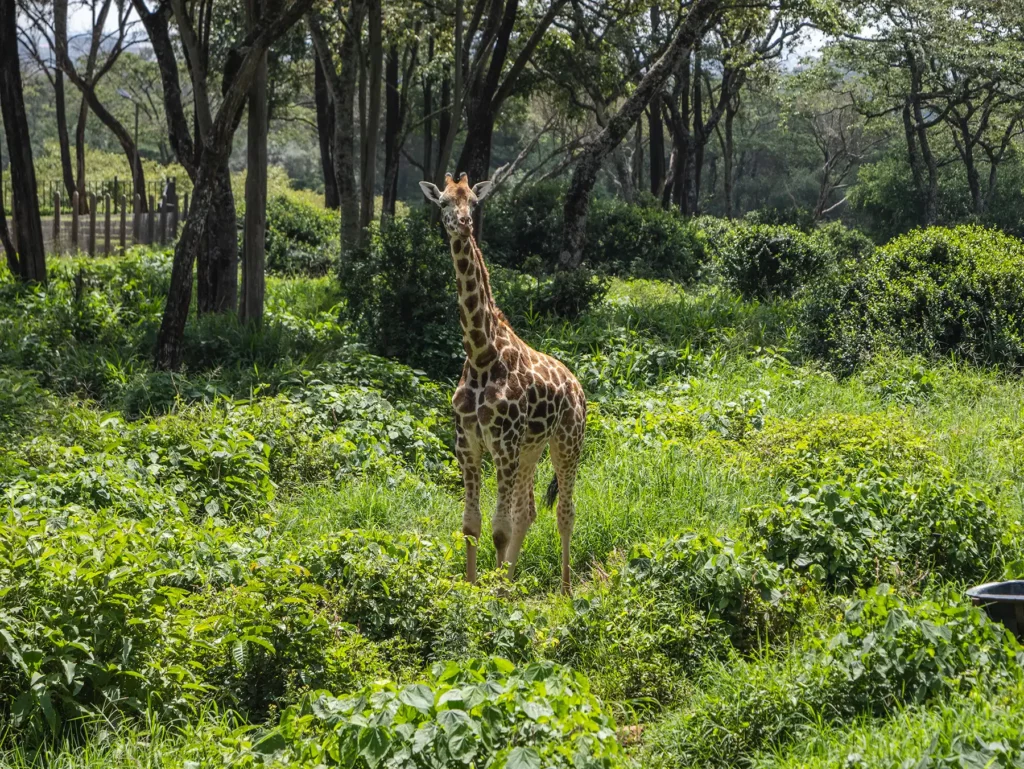
During my stay, I used Airbnbs; specifically, I stayed at Dawn Chorus in Loresho and The A-Frame in Karen. Both Loresho and Karen are great, safe neighbourhoods to stay in, and not far from lovely restaurants.
If you only have a little time before your safari, the Giraffe Centre would be my top pick in Nairobi. While I’m usually hesitant to recommend wildlife sanctuaries as too many of them are just zoos, this one is a great ethical choice. They’ve recently successfully released rare Rothschild Giraffes back into the wild which shows their hard work pays off! Visit in the morning when the giraffes are at their hungriest for the best feeding experience.

Day 2: Masai Mara National Reserve
Total drive time (excluding game drives): 5 hours
On your second day, it’s time to begin your trip with an amazing introduction to safari in East Africa – the world famous Maasai Mara National Reserve . Heading into the Masai Mara for the first time is one of those memories you never forget.
Masai Mara National Reserve Map
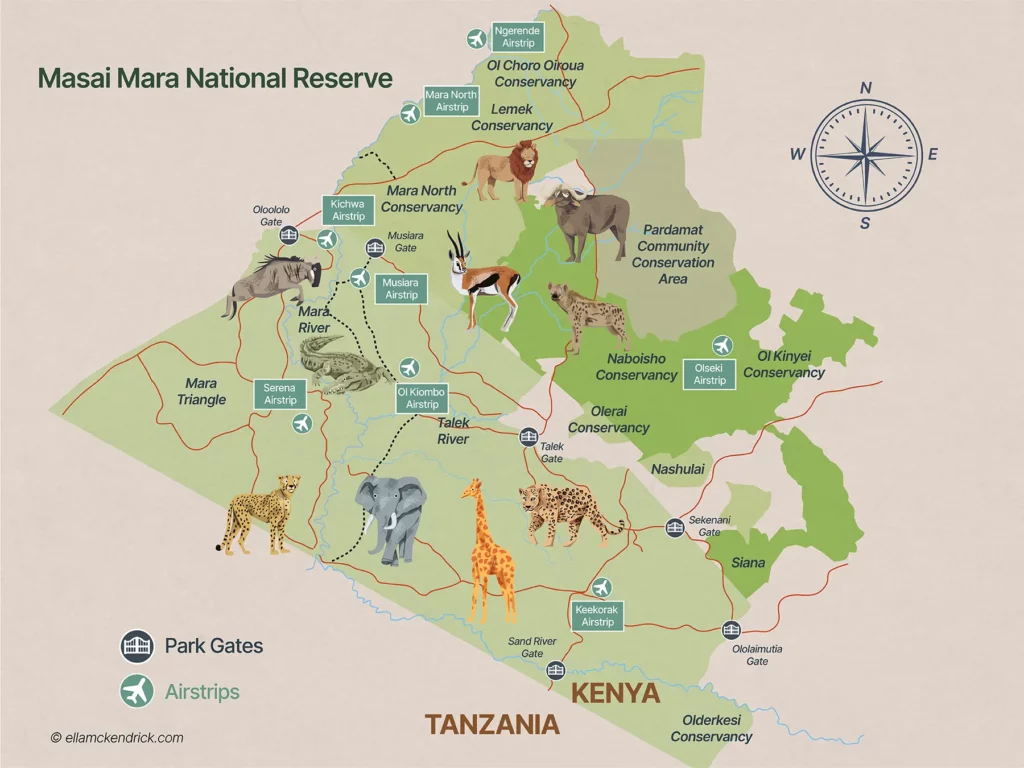
Itinerary
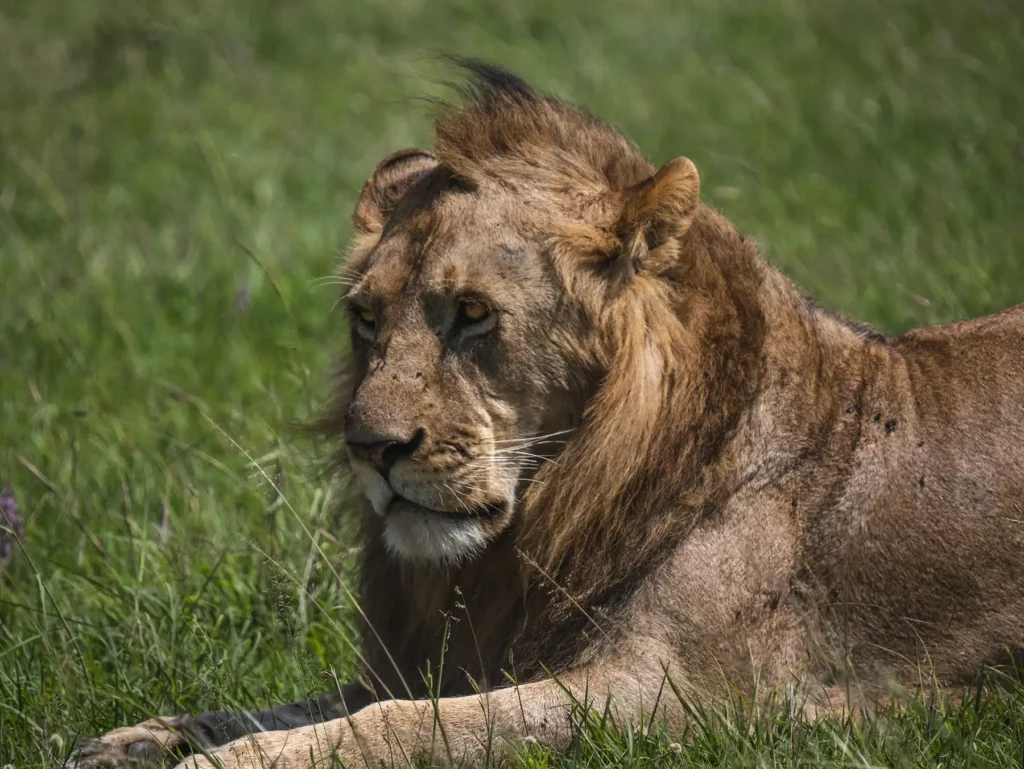
Your adventure to the Masai Mara starts at 8 am from Nairobi. During your drive, watch as the city scenes transform into wide open spaces. Along the way, you’ll stop at the Rift Valley viewpoint, which offers incredible views of the valley and beyond.
When you reach the Masai Mara around lunchtime, the lodge where you’ll stay welcomes you with a well-needed meal.
The highlight of the day is the afternoon game drive – your first chance to see wildlife on this itinerary! The Masai Mara is famous for its wildlife, including the big five, so there’s a high chance of seeing some of your absolute favourite animals. Big cats such as lions are frequently seen roaming the plains, whilst herbivores such as zebras and topis are found in abundance.
You’ll go out in your 4×4 with local guides who are experts in finding these animals in their natural habitat. As the sun sets, you’ll head back to your lodge.

About Masai Mara National Reserve
The Masai Mara National Reserve is part of the massive Serengeti ecosystem, which covers over 579 square miles (1,500 square kilometres) of primarily open grassland. Alongside the Big Five, the region hosts an impressive diversity of wildlife, including over 95 species of mammals and over 570 recorded species of birds.
The reserve is world-renowned for the annual Great Migration when over two million wildebeest, zebras, and gazelles migrate in a circular route from the Serengeti in Tanzania. The best time to see the Great Migration in Kenya is between July and October.
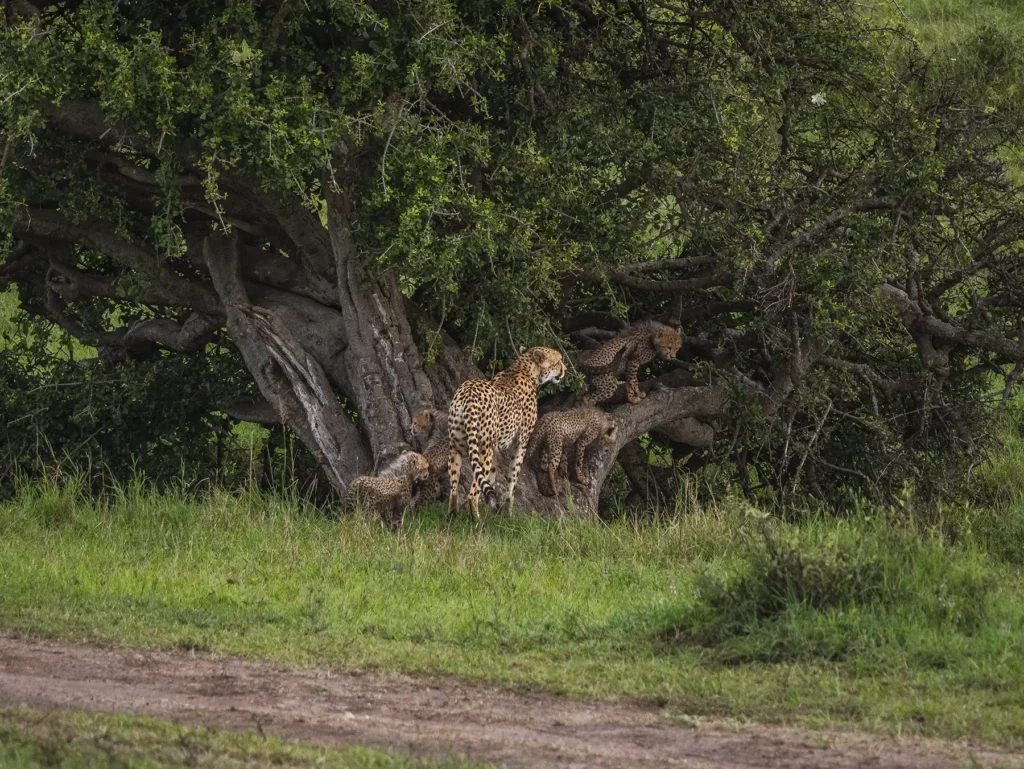
Tips for Visiting Masai Mara National Reserve
The dry seasons, from July to October and December to February, offer the best wildlife viewing opportunities, so although prices are slightly higher this is an ideal time to book your trip. If you wish to see the Great Migration in the Masai Mara, then booking between July and October is best.
The best times to try to spot predators are in the early mornings and late afternoons, when it’s cooler. This is when they’re more likely to be on the move.
As with all your upcoming safaris, your guide will provide you with guidance on respecting the wildlife – after all, we’re the ones in their home! Some good basics are to always maintain a safe distance from the animals and listen to the reserve rules.
Speaking of wildlife, your first safari also likely brings encounters with mosquitos! It’s important to protect ourselves from these sneaky insects. So use plenty of insect repellent and wear long sleeves and trousers during dawn and dusk to avoid mosquito bites.

Where to Spend the Night
When planning a trip to the Masai Mara, choosing where to stay is as important as deciding when to visit. There are various options, from luxury lodges to tented camps. Staying inside the reserve offers an immersive experience, while accommodations outside the park might be more budget-friendly (and there are many more options) but require longer drives to and from the park gates each day.
If you’re visiting during the Great Migration, staying near the Mara River area offers front-row seats to the dramatic river crossings. However, staying inside the reserve can come with a higher price tag.
Alternatively, staying near the Talek or Sekenani gates also provides really easy access to the park and prime wildlife spots, while being a bit cheaper than staying within the reserve itself.
Outside the reserve, you could also choose to stay in one of the conservancies bordering the Masai Mara, such as Mara North, Olare Motorogi, and Naboisho. These conservancies are a good option if you want to support sustainable tourism and community initiatives, though you’ll have longer travel times to get to and from the main reserve.
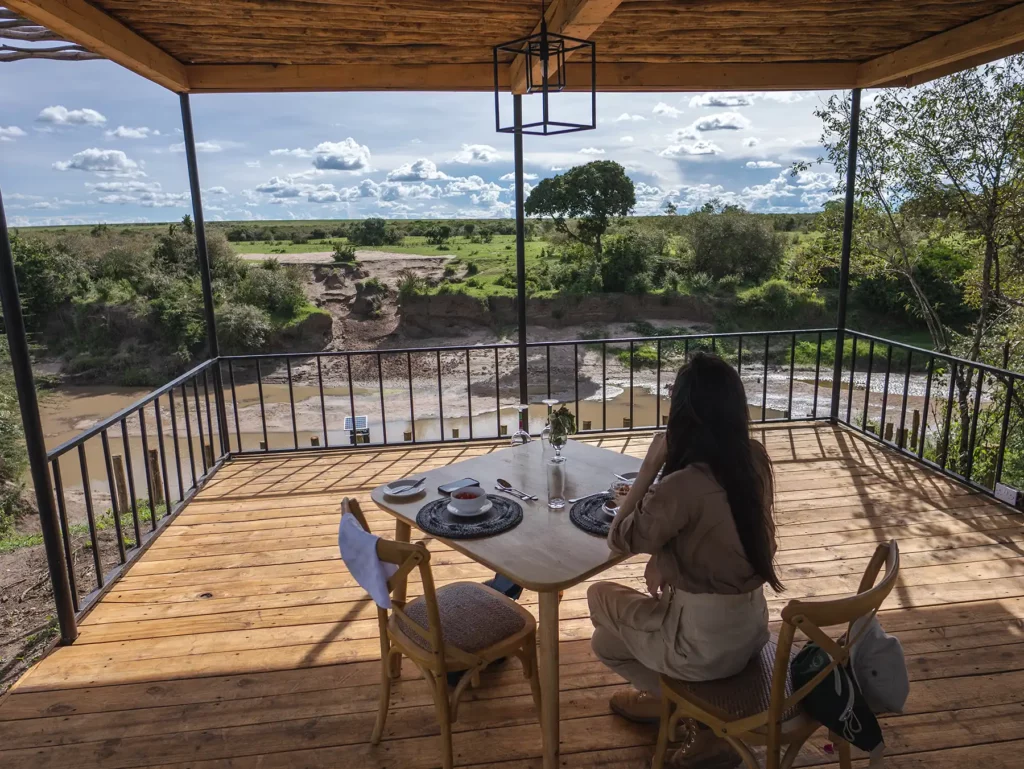
Day 3 – 4: Masai Mara National Reserve
Total drive time (excluding game drives): 0 hours
Over the next two days in the Masai Mara Game Reserve, you’re set for full-day game drives that promise unforgettable encounters with the reserve’s vast array of wildlife.

Itinerary
Each day starts early, as dawn is the best time to witness animals at their most active. The cool mornings encourage predators to roam and hunt before they retreat undercover as the weather heats up.
As the sun climbs higher, continue deeper into the reserve, driving past rolling grasslands and acacia forests. Your accommodation will provide a picnic lunch which you’ll enjoy from a scenic spot, looking over the savannah and perhaps seeing the beautiful animals roam by in the distance.
The game drives continue into the afternoon and as the day begins to cool, animals become more active again, providing excellent conditions for wildlife viewing.
The day’s adventure doesn’t end until dusk when the setting sun casts a golden glow over the landscape – it’s the perfect time for a photo of the Masai Mara’s stunning landscapes.

Where to Spend the Night
You’ll spend tonight at the same lodge as last night.

My Experience Visiting the Masai Mara National Reserve
I’m not alone when I say the Masai Mara is my favourite safari destination in Kenya, and I’m confident you’ll love it as much as I did!
One of my many memorable sightings here was of a mother cheetah with four adorably fluffy cubs. They must have only been a few months old! You can imagine how charmed I was watching them tussling with one another and jumping on their mother. Speaking of babies, I also saw a baby giraffe following its mother which was so, so cute.

I’ve also had one of my best leopard sightings here – she was up in a tree with a gazelle kill, before climbing down and eating it right by our car.
Lion sightings are amazing here too. Watching a pride relaxing after a successful hunt (we could tell it was successful due to the blood on their chests!) was phenomenal, and the best part was seeing a lioness nursing some very young cubs.
I also had fantastic sightings of hyenas, crocodiles, elephants, hyenas, jackals, and even a rare black rhino accompanied by an ostrich.
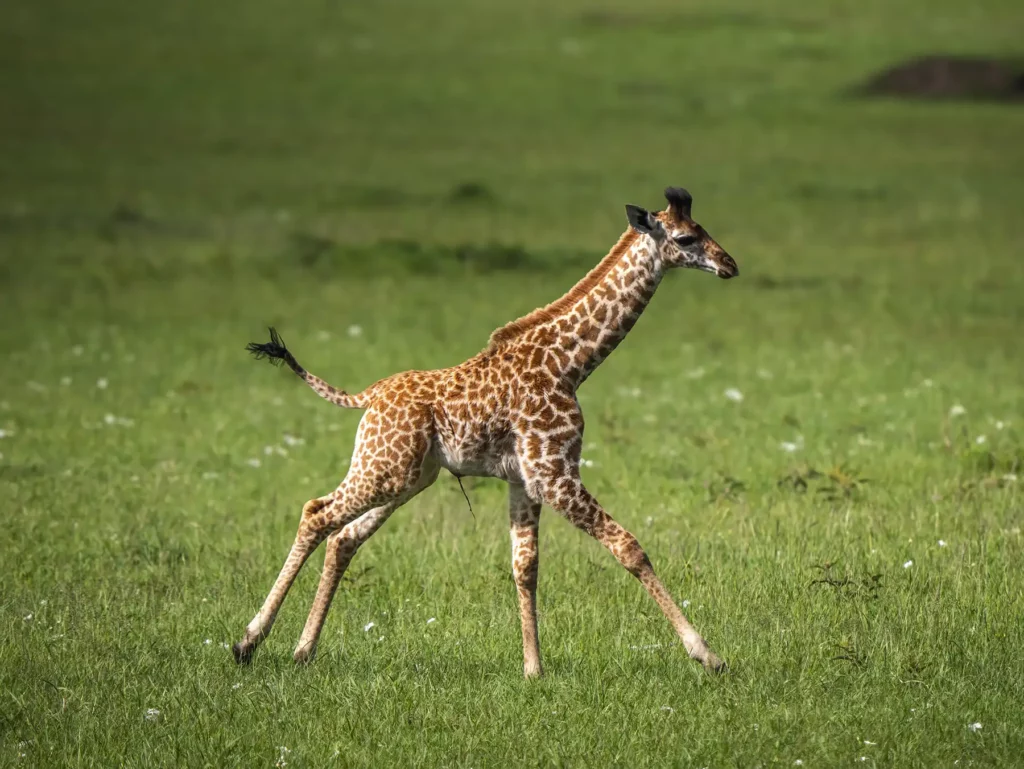
Day 5: Masai Mara to Serengeti National Park
Total drive time (excluding game drives): 10 hours or 3 hours by plane
Today you’ll journey from the Masai Mara in Kenya to the Serengeti in Tanzania, two of Africa’s most highly-regarded national parks.
Although each park is part of the same area, the border between Kenya and Tanzania makes the journey a bit more complicated – but thankfully, this will be a breeze for your local guide who does this all the time!
The drive takes around ten hours. Although the journey is scenic, this can be a bumpy drive so it’s not always the most comfortable.
Alternatively, flying cuts down the travel time to around 3 hours, including getting to and from airports. A plane ride gives you a fantastic view from above of the land and the Mara River snaking through it, alongside being a faster and easier way to get from one park.
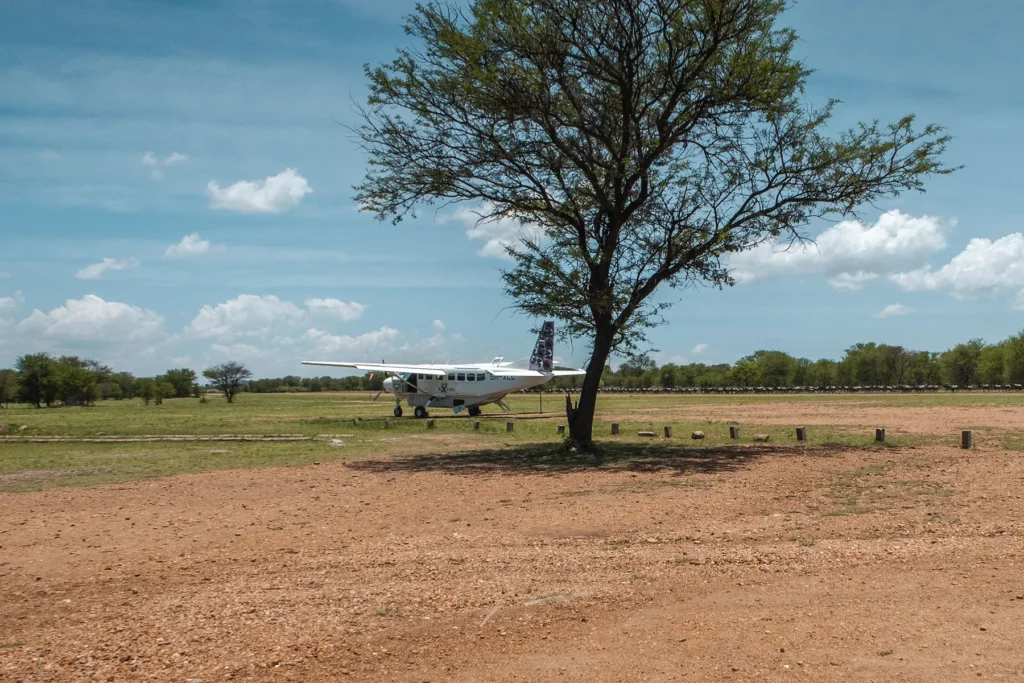
Itinerary
If you’re driving to the Serengeti, you’ll be getting up early to leave at around 7 am.
The first section of the drive lasts around five hours, as you head to Isibania, the border crossing between Kenya and Tanzania.
At Isibania, expect to spend around 30 minutes sorting out border crossing formalities. It’s a straightforward process, but hopefully an exciting one too – after all, you’re now visiting a whole new country. Welcome to Tanzania!

After crossing the border, you’ll continue with a 5-hour drive to your lodge in the heart of the Serengeti. Much of this drive is actually through the Serengeti itself and you’ll have plenty of opportunities to spot wildlife. On this drive I was lucky enough to see a leopard in the tree right by the road!
Taking a flight significantly reduces travel time, giving you a bird’s eye view of the incredible landscapes below and more time to relax at your destination. If you’re planning on flying, you must first fly to the Migori Airstrip (still in Kenya) from the Masai Mara. The Migori Airstrip is a 30 minute drive from the Isibania border post.
You’ll then cross the land border at Isibania and drive for another 14 minutes into Tanzania and arrive at Tarime Airstrip. Finally, you will then fly from Tarime to Seronera in Central Serengeti. So, although flying is a lot quicker, it will still take several hours.
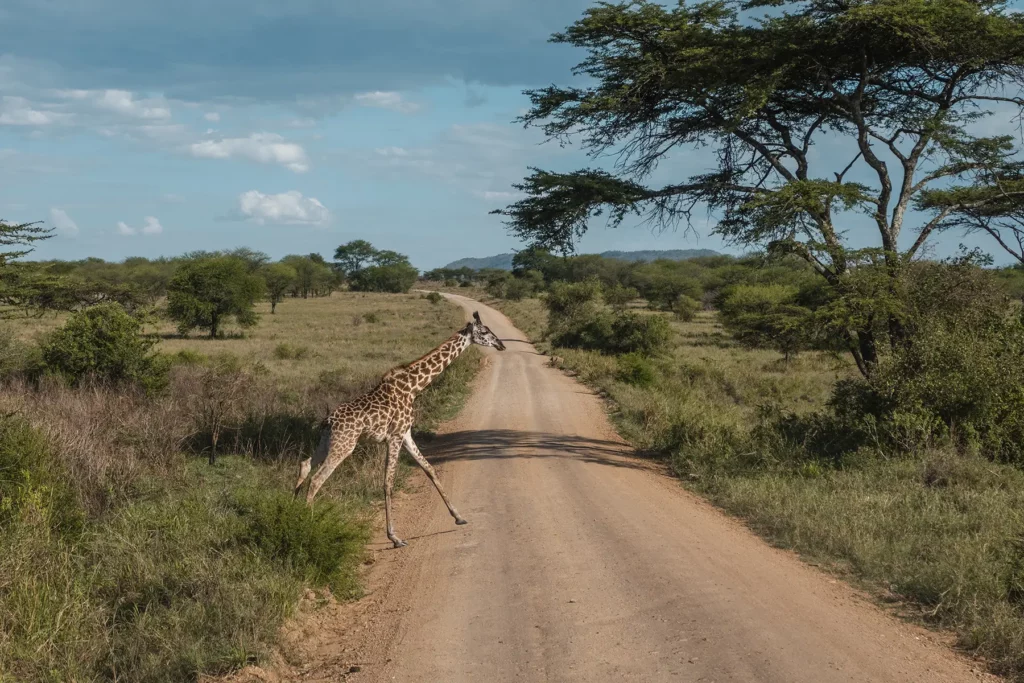
Tips for Your Journey to Serengeti National Park
It took me 10 hours to drive from the Masai Mara to Serengeti. I was staying near Ololaimutiek Village which is in the bottom right corner of the Masai Mara and perhaps the worst location to stay if you’re planning on making the journey as it’s furthest away from the border with Tanzania.
To shave time off your drive I’d recommend instead that you base yourself in Talek, or if you wanted to have the shortest possible journey, stay in Mara North Conservancy. This will save you 2 hours on the road.
If you’re driving between the two destinations, be prepared for a long car ride and so come prepared with neck pillows, books and other personal items to hand.
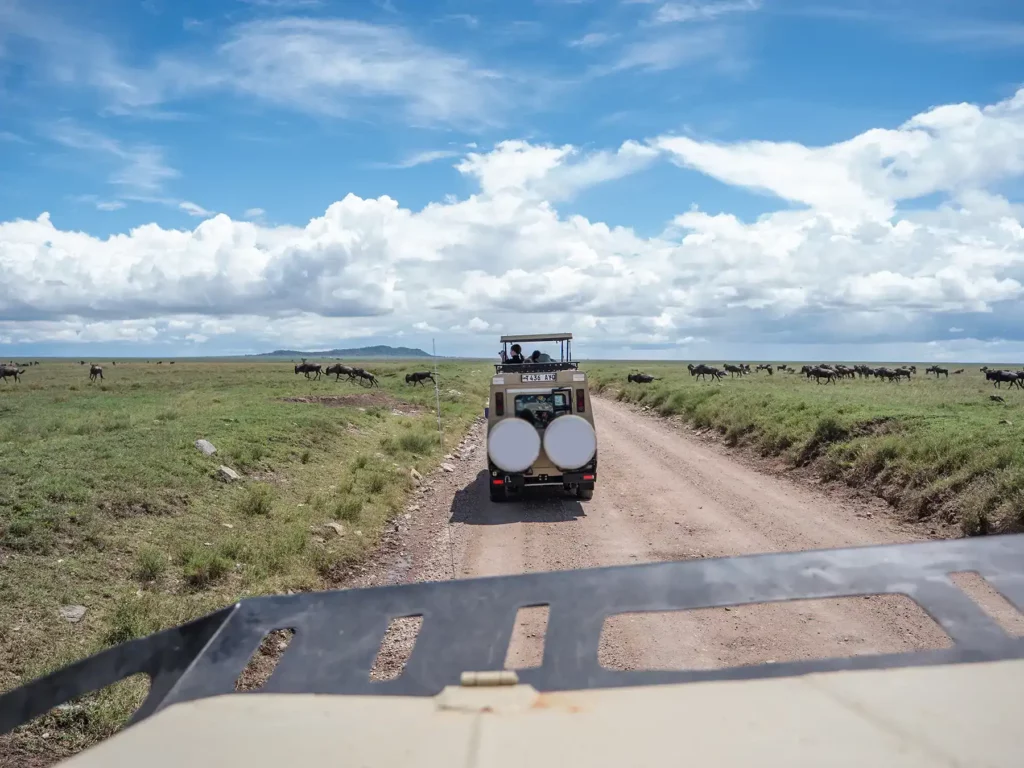
You will be switching vehicles at the border, so make sure all your belongings are organised and ready for your vehicle switch. I’d also recommend having your passport, visa and yellow fever certificate accessible to make your border crossing as smooth as possible.
There will be multiple opportunities to use the bathroom on route. Bathrooms can be found at all park gates (the gate exiting the Masai Mara and the gate arriving in Serengeti) as well as at the border post. Although they are in good condition, they don’t always have toilet paper so I recommend having some on you at all times just in case.
Just a heads-up, the Serengeti’s home to tsetse flies which have an uncomfortable bite and have a thing for dark clothes. So, it’s smarter to stick to lighter shades (greys, beiges and muted greens are best) and don’t forget your insect repellent to keep them at bay.
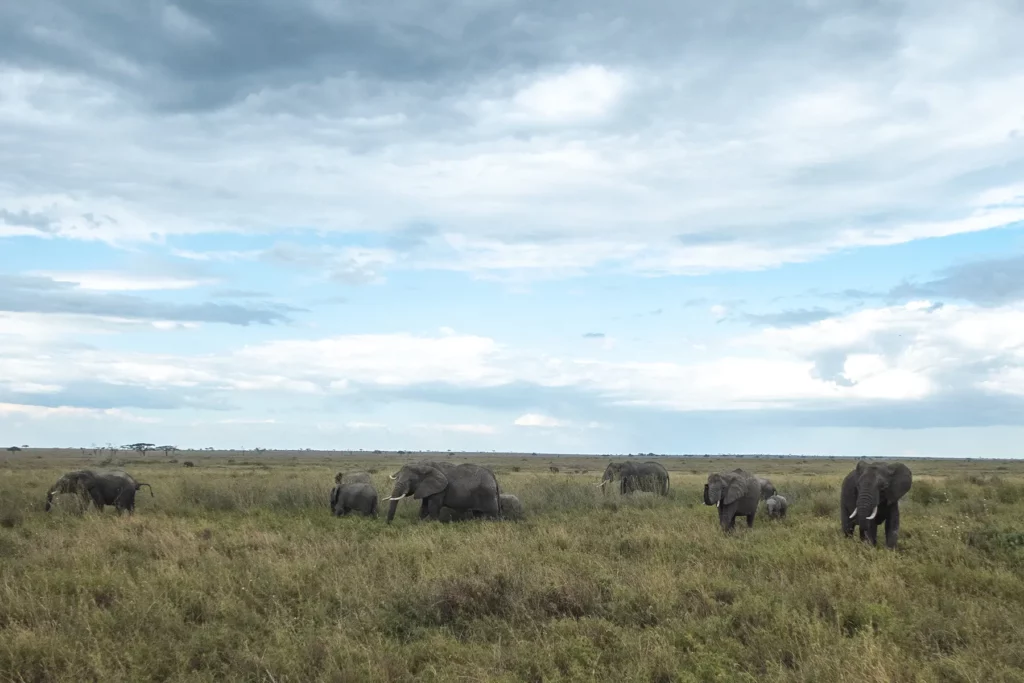
Where to Spend the Night
When it comes to bedding down for the night in the Serengeti, where you choose to stay can shape your safari experience.
Most times of the year, the Seronera region is a solid choice. It’s smack bang in the middle of the park, making it a hotspot for wildlife all year round. The area’s well known for its fantastic leopard and lion sightings, plus it’s got a good spread of lodges and camps to suit different tastes and budgets.
However, if you’re planning your visit between July and September, you might want to consider staying in Kogatende. This time of year is all about the Great Migration, and Kogatende is the place to be if you want to catch the dramatic river crossings. It’s a bit more remote than Seronera, which can mean a slightly longer drive to get there, but it’s worth it to witness one of nature’s most incredible events.
As always, staying outside the park gates is cheaper. But since the Serengeti is huge, it’s worth staying inside the reserve in this case, otherwise you’d spend hours each morning driving into the park to reach the core wildlife areas, missing out on the best time to actually see the animals. Staying outside the park also invalidates your 24 hour pass into the Serengeti as it’s only valid if you stay the night there. This means you could end up paying double the park fees when staying outside the gates, so the money saving isn’t as good as it may first appear.
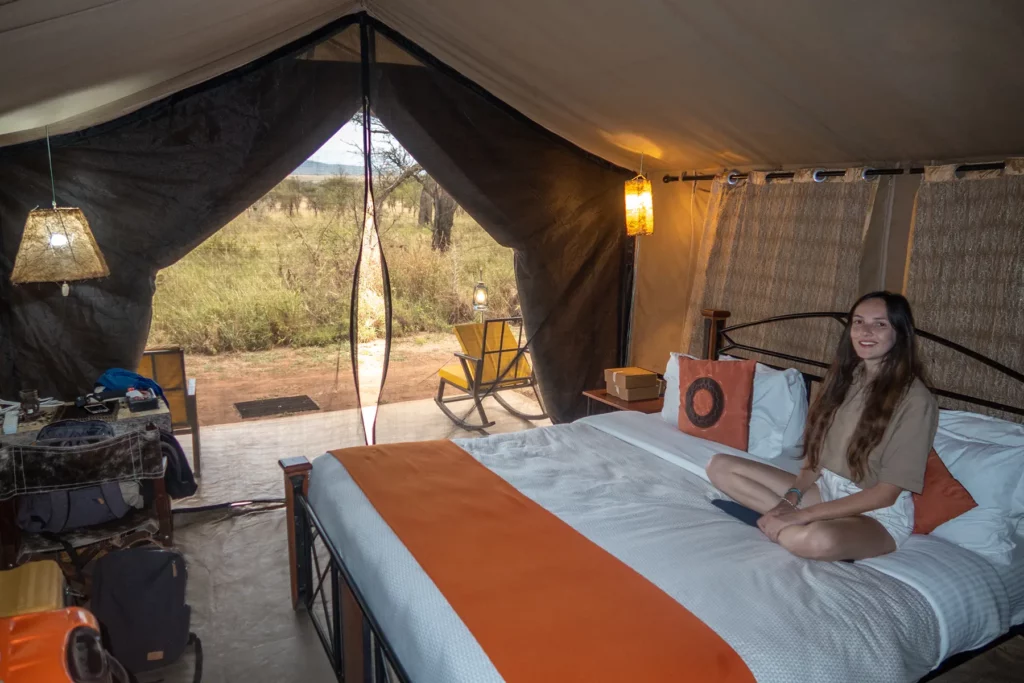
My Experience Driving from Masai Mara to Serengeti
It took me 10 hours to drive between my lodge in the bottom eastern corner of Masai Mara to Serengeti. If I was to make this journey again, I’d definitely base myself in Talek or Mara North, to shave up to 2 hours off the drive.
The first half of the drive is the most challenging as the road between Masai Mara and Isibania is very poor, with lots of huge potholes, which makes driving very slow.
Most of the journey involves navigating down dirt roads. However there is a stretch of tarred road that starts shortly before reaching Isibania and continues into Tanzania for around an hour.
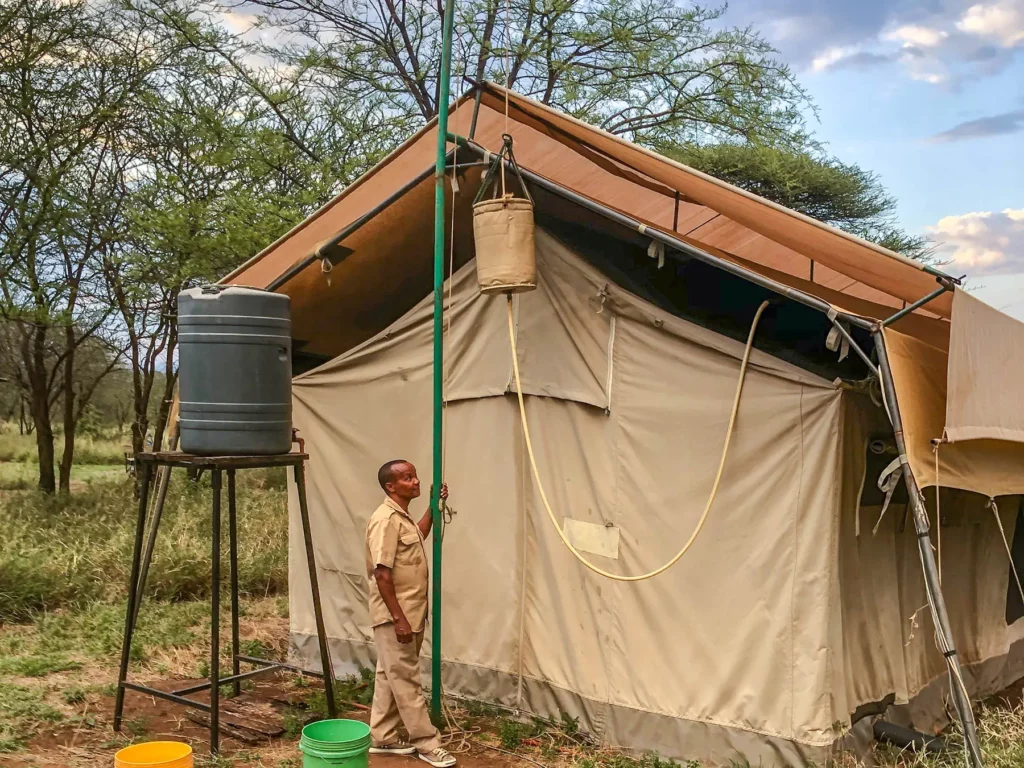
I personally love long drives. I find it so relaxing to stare out the window and admire the unique scenery. You’ll pass through quaint villages, witness dozens of cow crossings and even see some wildlife along the way. Spotting zebras grazing amongst cows was surprisingly common!
I found the border crossing very smooth. It took me 10 minutes to stamp out of Kenya and into Tanzania. However I will mention that I was visiting outside of peak season and there may be queues between June and October. I also had my Tanzanian visa purchased online in advance which also sped up the process.
The last 3 hours of the drive is essentially a game drive through Serengeti as you meander to your lodge in the heart of the park. I was lucky enough to see a leopard, a pride of lions, a huge troop of baboons, dozens of giraffes and much more on my drive.
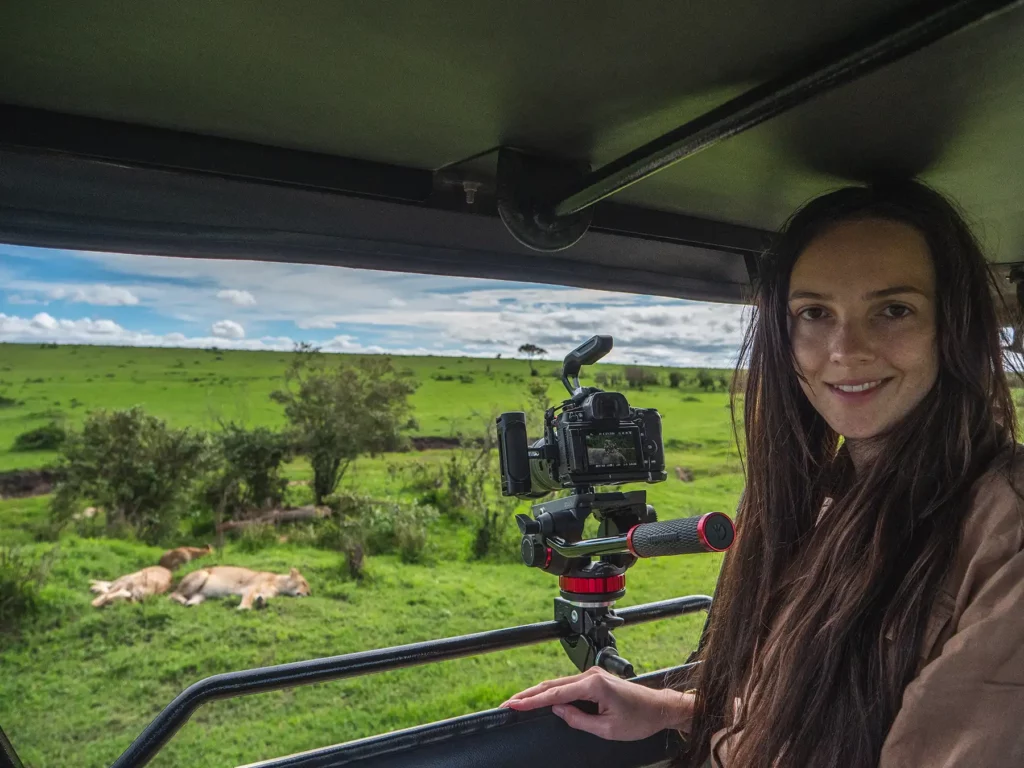
Day 6: Serengeti National Park
Total drive time (excluding game drives): 4 hours if staying in Kogatende (Northern Serengeti) the previous night, otherwise 0 hours
Exploring the Serengeti National Park is a highlight of any East African adventure. Today, your full-day game drive is likely to involve some of the best wildlife viewings of your trip. Enjoy it!
Serengeti National Park Map

Itinerary
Starting at dawn, your drive through the savannah will start with looking out for lions, cheetahs, and leopards on their early morning hunt.
As the day progresses, head towards the waterholes and river valleys central to the Serengeti ecosystem. The park’s diverse environments maximise your opportunities to see a wide array of wildlife, from the elusive leopard to vast herds of wildebeest and zebra.
You’ll head back to your lodge at dusk. After dinner, I’d recommend sitting round the lodge campfire and gazing at the dazzling night sky, which is spectacularly vivid so far from light pollution. And the sounds of nocturnal animals make star-gazing here extra atmospheric! Listen out for the eerie whoops of hyenas and the distant roaring of lions.

About Serengeti National Park
Sprawling across 5,695 square miles (14,750 square kilometres) of northern Tanzania, It’s no wonder that Serengeti translates to ‘Endless Plains.’ This world-renowned national park is a haven of biodiversity and a UNESCO World Heritage site.
Alongside Kenya’s Masai Mara, Serengeti also hosts the epic Great Migration; each year, over 1.5 million wildebeest, alongside hundreds of thousands of zebras and gazelles, traverse its plains in search of fresh grazing. Behind them, they’re closely followed by predators such as lions, leopards, and hyenas.
Serengeti’s landscape is a mixture of savannah, grasslands, and woodlands. These habitats support over 2,500 lions—the largest population of lions in Africa.
For further reading, see my Complete Guide to the Serengeti National Park
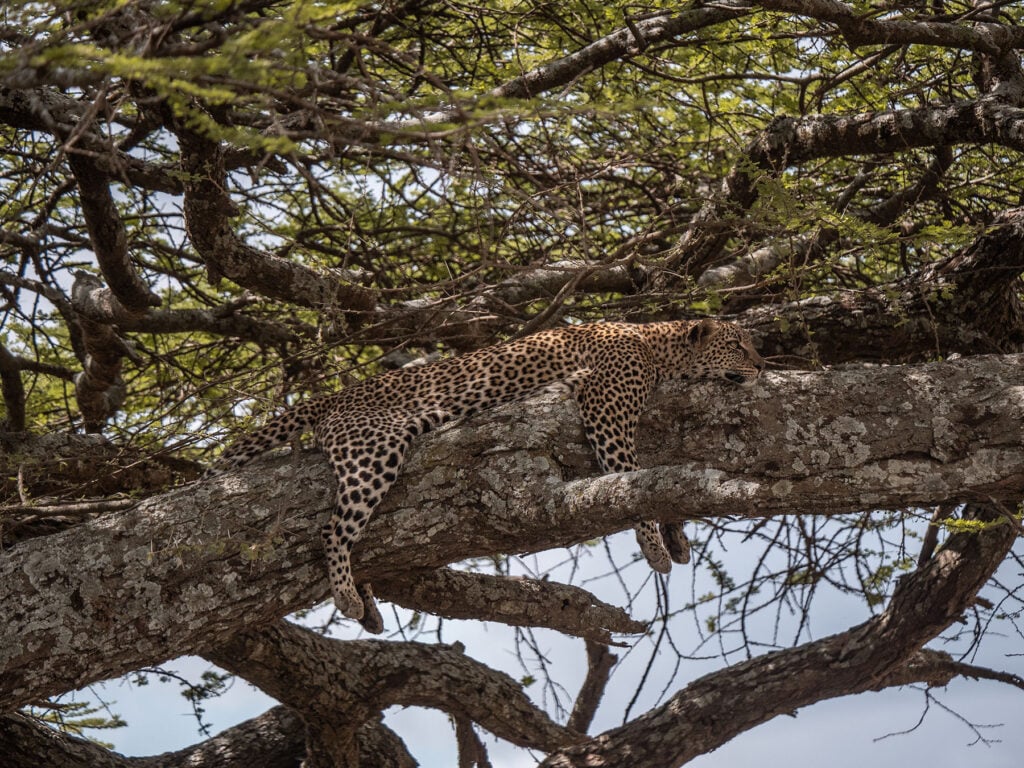
Tips for Visiting Serengeti National Park
When going on a full-day safari in Serengeti, it’s always best to ask your accommodation for a picnic lunch rather than going back to your lodge to eat.
The reason? The Serengeti’s vast, and spending the whole day out there means you get to see loads more than just the bits close to where you’re staying.
Bring some strong sunscreen for your safari, even under cloudy skies. Carry it with you so you can top it up during the day. And although the Serengeti mornings can be pretty cool, it heats up by midday. Dressing in layers is the way to go, so you’re comfy no matter the weather. You’ll also want to bring your reusable water bottle, a good camera if you have one, and binoculars.
To witness the Great Migration, visit between June and October when the wildebeest crosses the Mara River. For the calving season, late January to February is best.
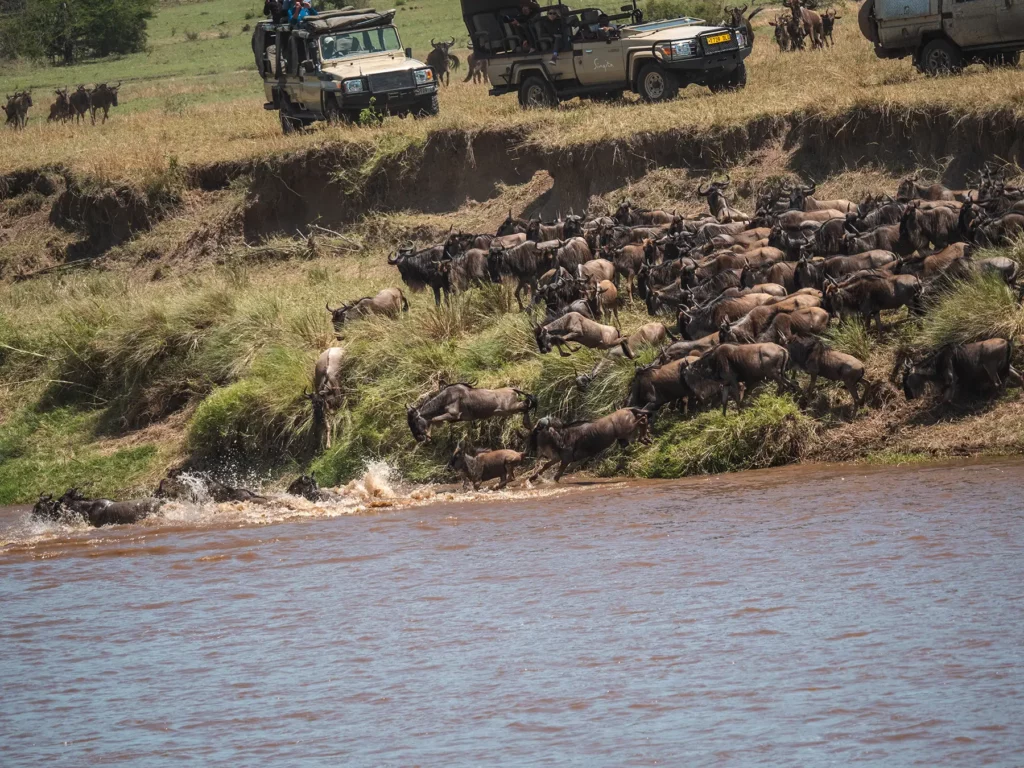
Where to Spend the Night
Since the park is so famed for its wildlife viewing opportunities, opting for a night inside the park means you’re perfectly positioned for early morning and late afternoon game drives.
The range of accommodations caters to everyone, from luxury tents that offer a bush experience to lodges that provide a comfortable retreat under the stars.
The Seronera’s central location is ideal and means that you’re in a prime spot to wake up to the sounds of the Serengeti, with the possibility of wildlife right on your doorstep.
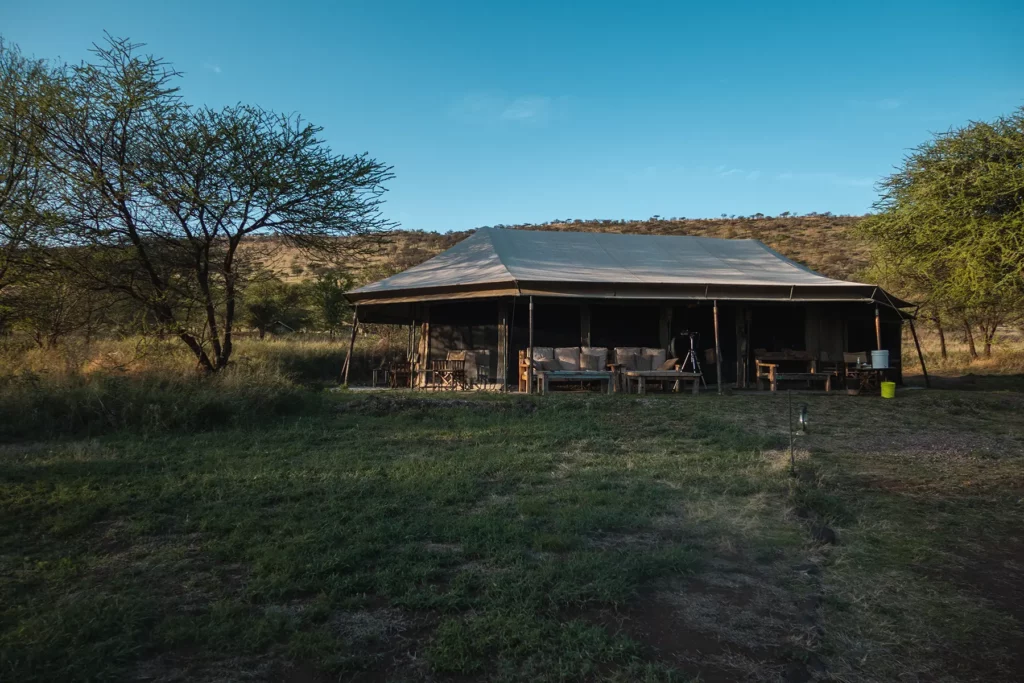
My Experience Visiting Serengeti National Park
No matter how many times I visit Serengeti, it never disappoints. The animal viewings are truly wild.
While staying in central Serengeti, I saw three leopards in a single day (including a cub with its mother!), and also watched cheetahs feed on a freshly caught wildebeest.
If you love lions, you’re in for a treat. I saw so many while in the Serengeti! From the rare tree-climbing lions to a pride resting beside a stream and a pregnant lioness stalking some zebras, every sighting was incredible.
On my second visit, I saw hundreds of elephants marching through the savannah, which was amazing. Other animals I’ve seen include many giraffes and hyenas, alongside topis, zebras, dik-diks, hippos in hippo pools, Thomson’s gazelles, impalas, baboons and much more.
In Northern Serengeti, I visited to see the Great Migration river crossings. If you do visit during this season, I recommend spending at least a full day in the North for a chance to see the crossing; the wildebeest can spend hours milling around the riverbanks before bravely deciding to cross! For me, witnessing the crossing was emotional as it’s been a lifelong dream – it is exceptionally special to witness.
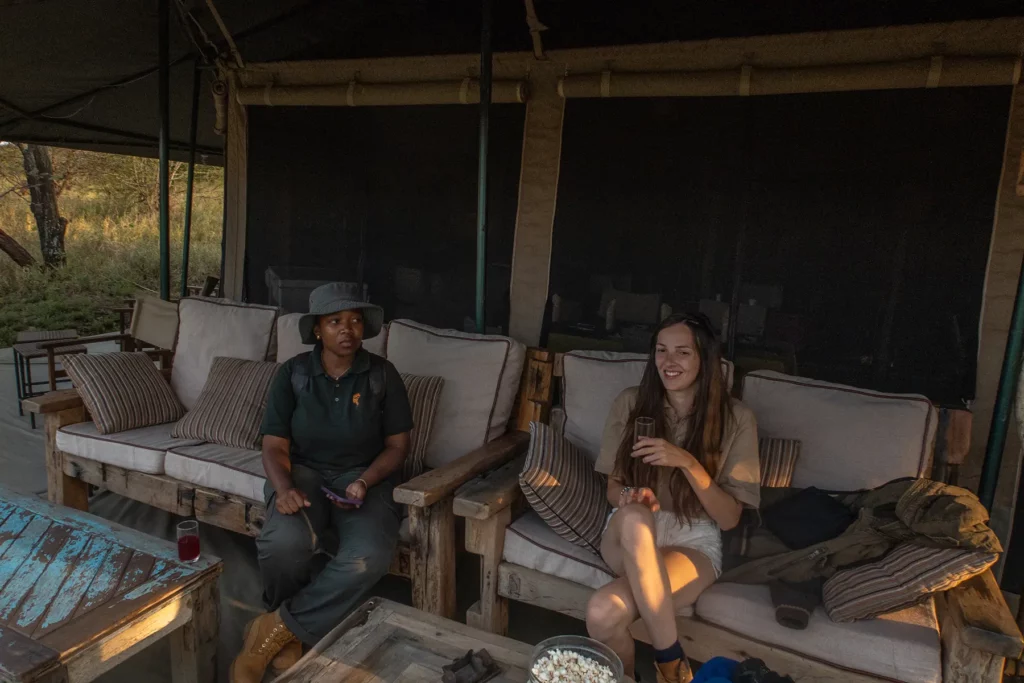
Day 7: Serengeti National Park
Total drive time (excluding game drives): 4 hours
You’ll begin another day in Serengeti National Park for a morning game drive. After lunch, you’ll head towards the Ngorongoro Conservation Area for the next part of your itinerary.
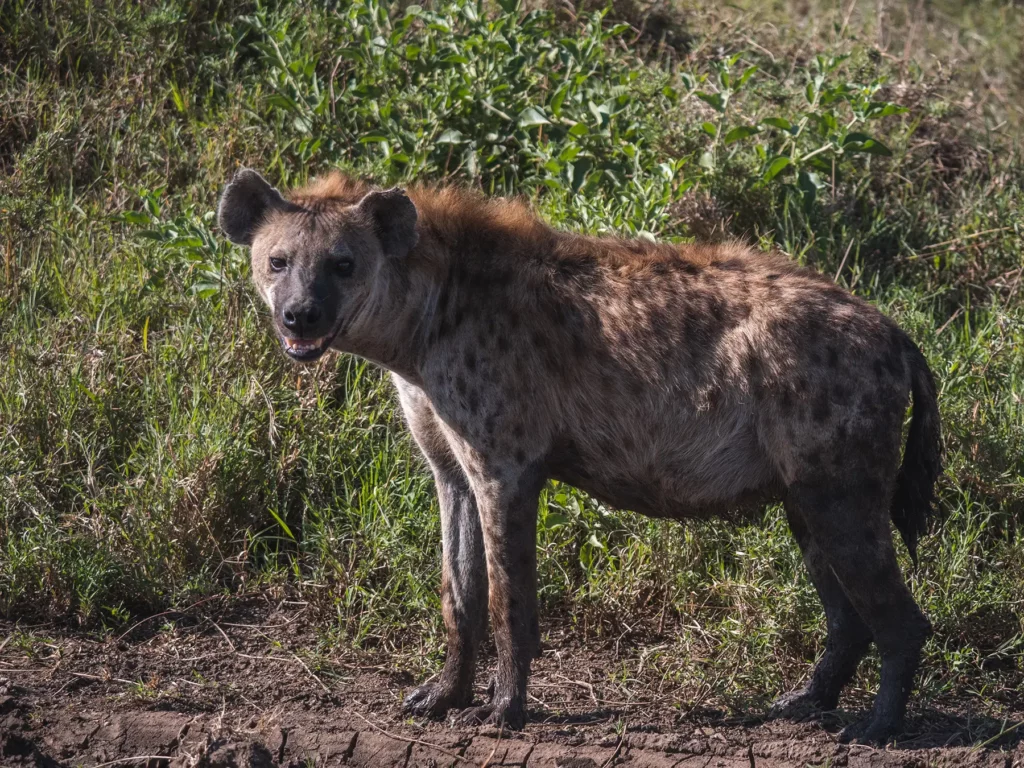
Itinerary
Wake up early again so you have the best chance of seeing predators such as big cats on their morning hunts. Today, your game drive will finish around lunchtime.
In the afternoon, you’ll start heading towards the Ngorongoro Conservation Area. This drive is special because you get to see the change in scenery from the vast plains of the Serengeti to the more varied landscapes of Ngorongoro.
In the afternoon, you’ll drive towards Ngorongoro, heading towards the crater rim where you’ll spend the night. Staying on the elevated crater rim offers stunning views down towards inside the crater itself, a world-famous wildlife haven. If the timing works out, the sunsets here are spectacular.

Where to Spend the Night
Tonight you’ll be staying around Ngorongoro Conservation Area.
If you have the budget for it, staying on the crater rim is ideal. The lodges here range from mid-range to luxury, offering not just a bed for the night but spectacular views right on the edge of the crater. These lodges provide top-notch facilities and the perfect starting point for tomorrow’s activities.
For a more budget-friendly alternative, Karatu town is a brilliant choice. Just outside the Ngorongoro Conservation Area, Karatu offers a range of more affordable accommodations, from guesthouses to comfortable hotels.
Staying here means you’re still within easy reach of the crater, but also have the chance to explore the rural life in northern Tanzania. The town is well-known for its coffee plantations and local markets, making it a great spot to mix things up and experience Tanzanian culture alongside your safari adventures.

Day 8: Ngorongoro Crater
Total drive time (excluding game drives): 3 hours (30 minutes to the crater and 2.5 hours to Tarangire after your safari)
Maximise your visit inside the Ngorongoro Crater by starting early, as soon as the gates open. Descending into the crater, you’ll be greeted by a landscape home to lions, rhinos, elephants, and more. A midday picnic by a hippo pool offers a unique dining experience. After lunch, you’ll have more time to explore before heading to your next destination, Tarangire National Park.
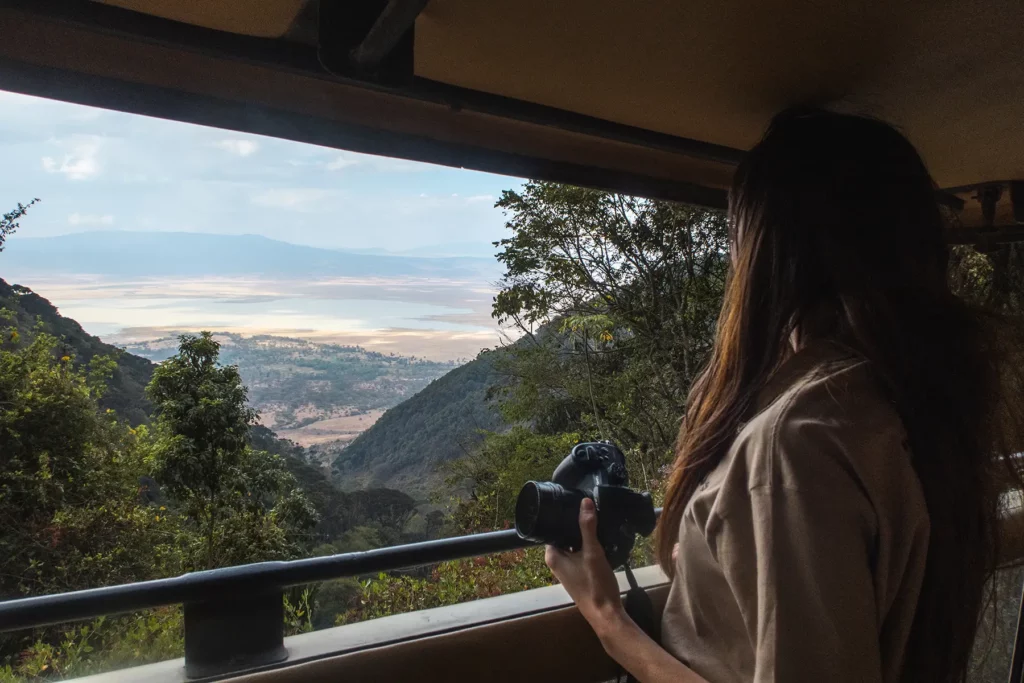
Ngorongoro Crater Map
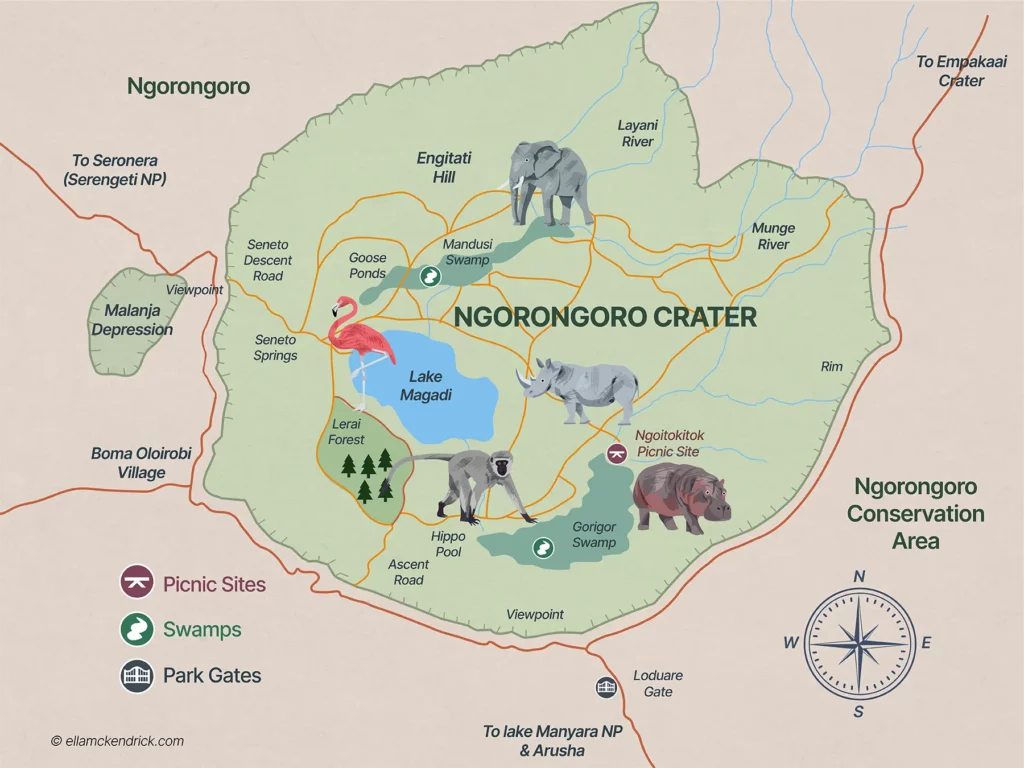
Itinerary
The park gates open at 6 am, and it’s best to be there right when they do; as always, during the cooler morning hours, the animals are most active.
As you descend into the crater, you’re entering a world that feels almost timeless, with its open grasslands, lakes, and woodlands. The crater is a haven for wildlife including lions, rhinos, elephants, and many more.
A highlight of the day will be stopping for a picnic lunch by a hippo pool. It’s a chance to relax and enjoy your surroundings, watching the hippos in their natural habitat while you eat. There’s something truly special about dining in such close proximity to wildlife!
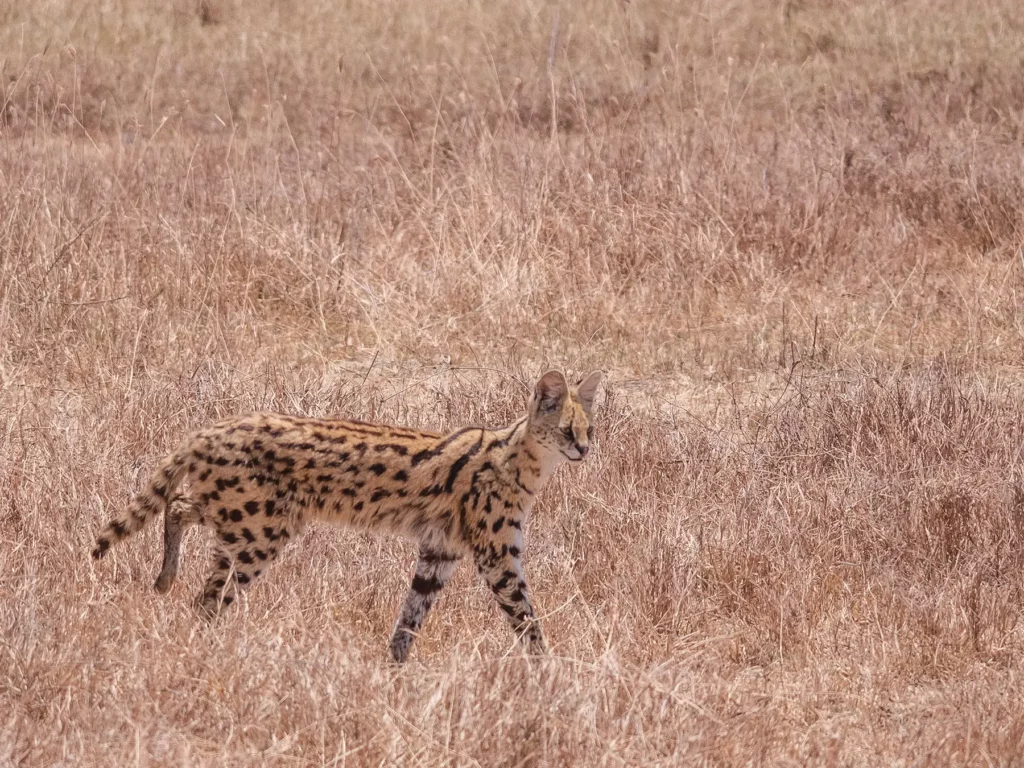
After lunch, you’ll continue exploring the crater, soaking up as much of the scenery and wildlife as you can before leaving in mid-afternoon.
Next, it’s off to Tarangire, where you’ll spend the night. This park is known for its elephants and baobab trees, so get a good sleep so you’re ready for tomorrow!
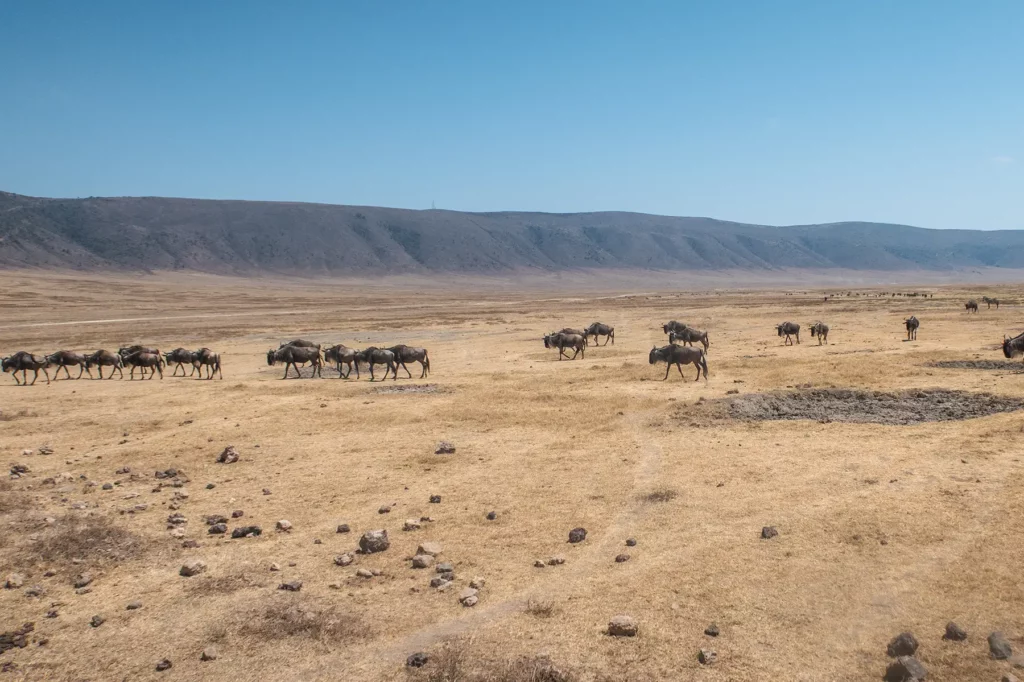
About Ngorongoro Crater
Formed 2- 3 million years ago, this volcanic caldera was created when a gigantic volcano erupted and subsequently collapsed. This resulted in one of the largest intact calderas worldwide, with the floor covering around 260 square kilometres.
Spanning around 12.5 miles (20 kilometres) in diameter, the crater walls rise to 400 to 610 metres high, thus ‘trapping’ the wildlife within the crater rim. This natural enclosure makes it a really special experience for visitors, as you’re pretty much guaranteed to see animals here all year round.
For further reading, see my Complete Guide to Ngorongoro Crater

Tips for Visiting Ngorongoro Crater
Since you’ll be cutting your game drive short to travel to Tarangire, aim to enter the crater at dawn. The early morning light is not only beautiful but it’s also when animals are most active, and you’ll beat the crowds. This is a great time to visit as the rhinos are most likely to be spotted in the mornings, before they head off into the forests for the day.
Don’t forget your binoculars, camera, sunscreen, water, extra layers, and insect repellent.
I personally found Ngorongoro Crater to be very windy and so if you have sensitive ears, like I do, you’ll want to bring some kind of protection like a beanie hat.
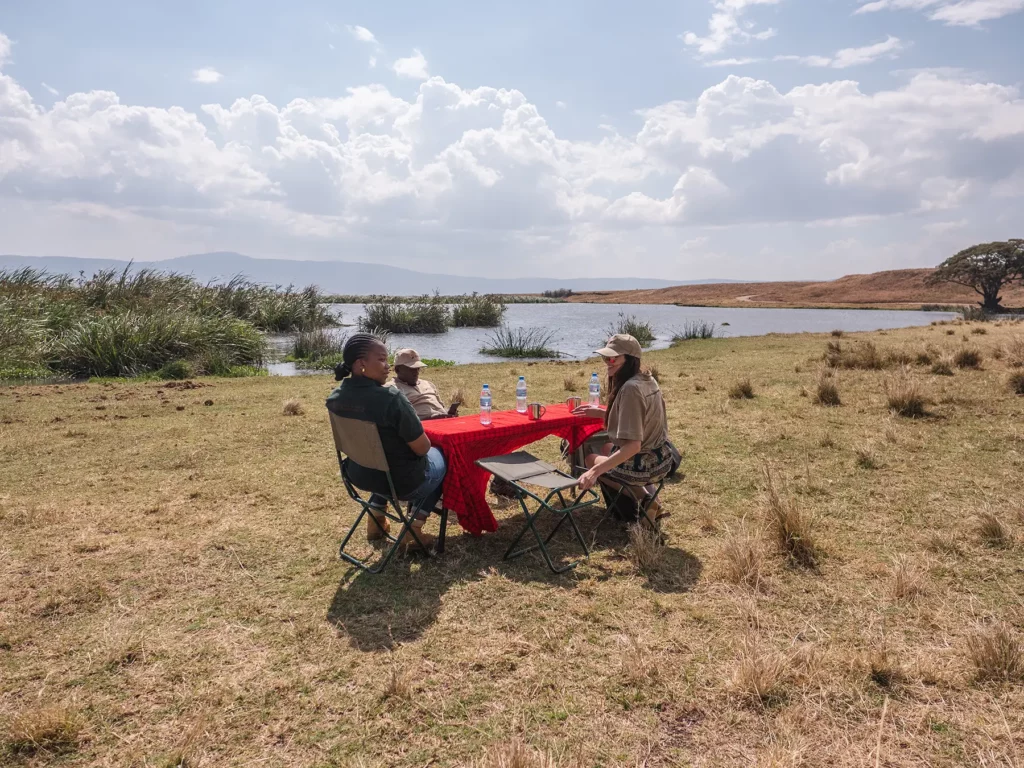
Where to Spend the Night
You’ll spend tonight staying within or close to Tarangire National Park. There’s a wide range of accommodations from budget-friendly campsites to more luxurious lodges. Options within the park itself are advantageous in terms of saving driving time tomorrow, though are slightly pricier.
Bear in mind that this is your last night staying within a safari location, so you might want to use this opportunity to splurge on something special.
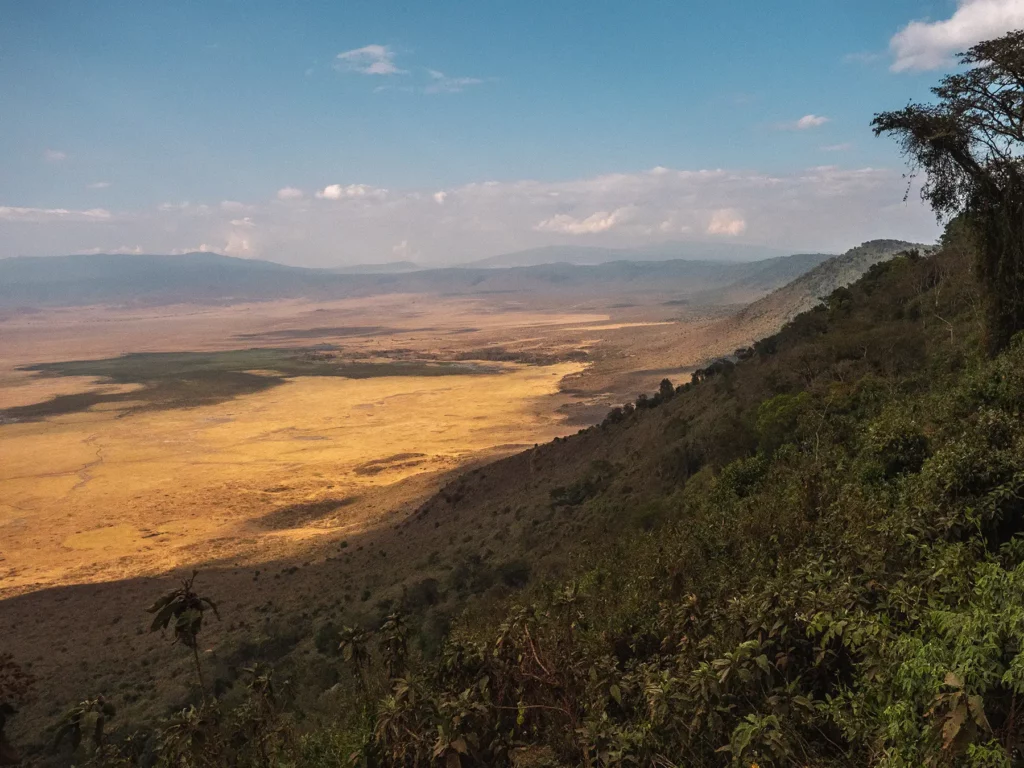
My Experience Visiting Ngorongoro Crater
Approaching the crater rim, surrounded by dense forest and thick mists, was such an atmospheric moment, and the anticipation of what I would see within the crater only added to the magic.
Once we descended into the crater and I saw the flat savannah below, it only got better. I saw hyenas, buffalos, countless wildebeest, zebras and gazelles, and a warthog family too. At Lake Magadi, I saw pink flamingos feeding in the shallows, alongside hippos keeping cool in the alkaline waters.
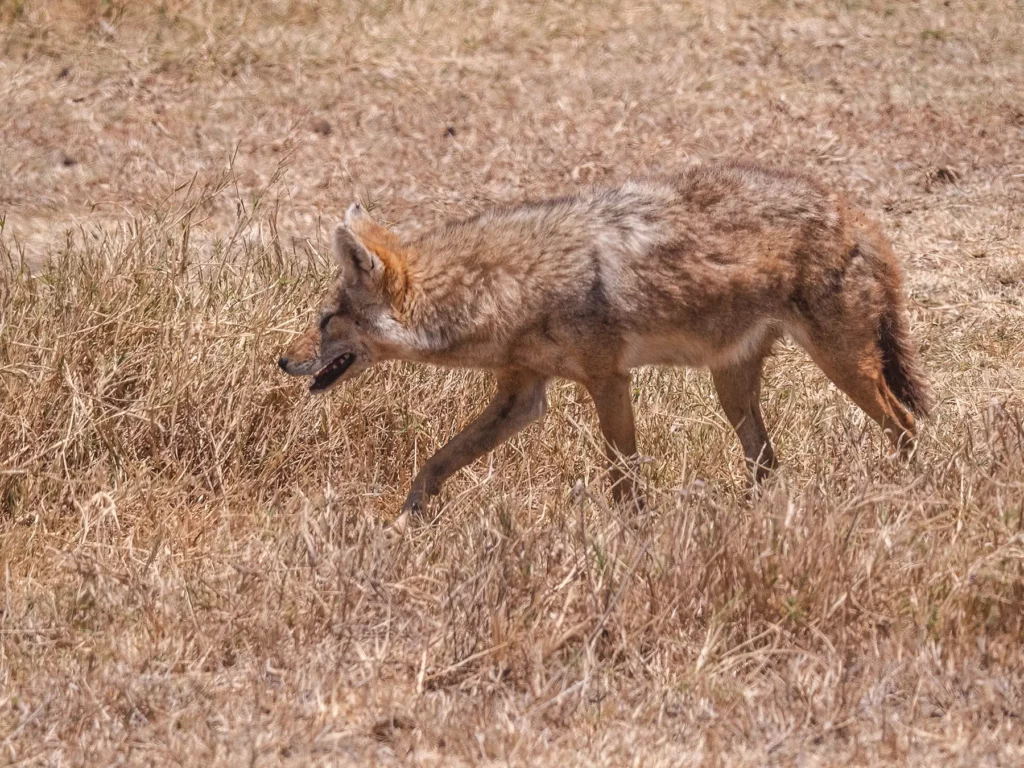
But one of my absolute favourite sightings here was of a serval, a small cat that’s rare to see in the daytime! And then, moving through the yellow grass, I saw two more, all prowling through the savannah! One did an elegant leap before squarely catching its prey – presumably a mouse – before gobbling it up.
To top things off, I also saw lions, elephants, tons of birds, and an African golden wolf. This truly is a brilliant park and one of my favourites in East Africa.
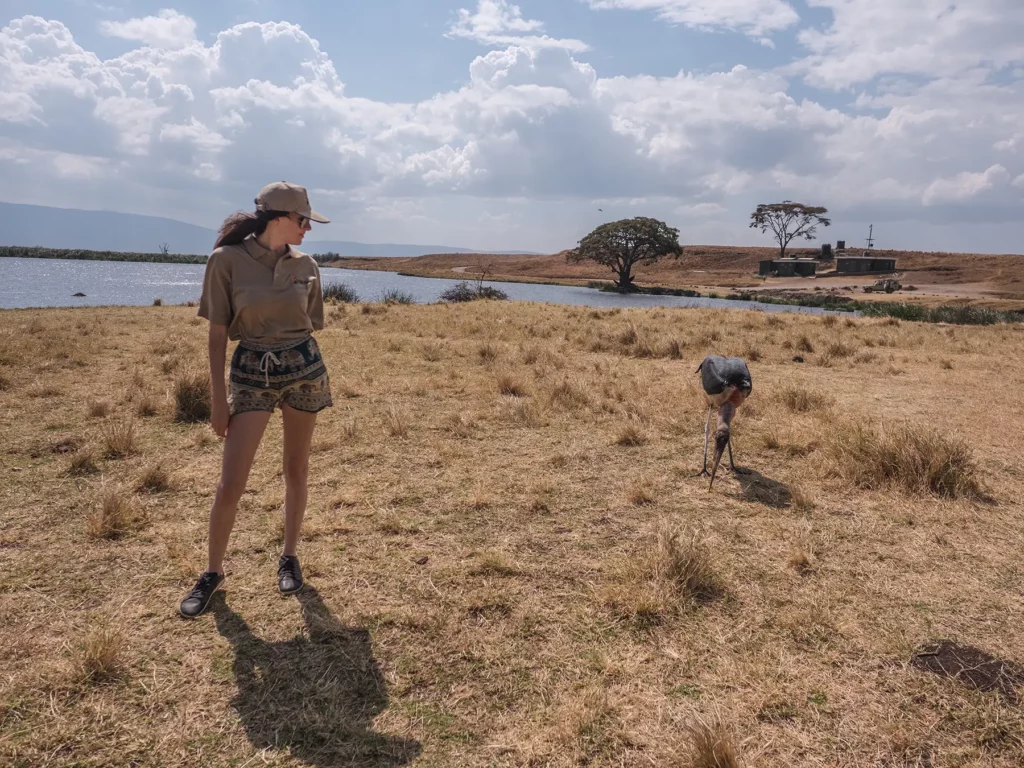
Day 9: Tarangire National Park
Total drive time (excluding game drives): 3 hours
Visiting Tarangire National Park is a fantastic place to finish your Kenya and Tanzania trip on a high. I hope you have a blast on your final safari experience before returning to Arusha.
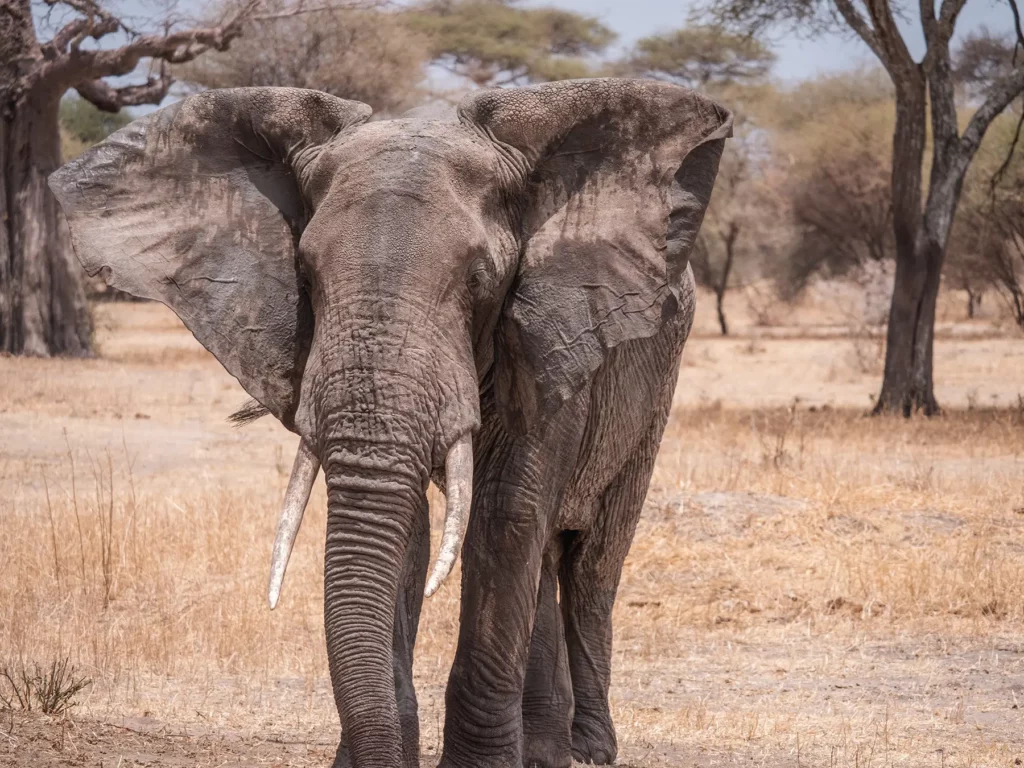
Tarangire National Park Map
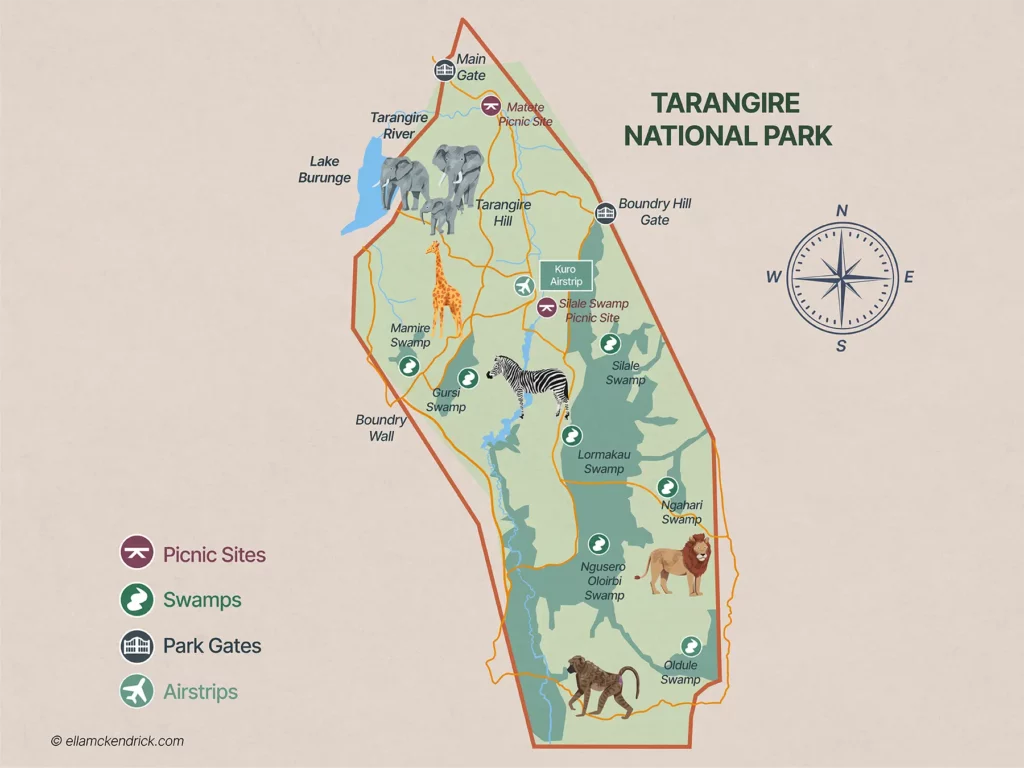
Itinerary
Known for its large herds of elephants, majestic baobab trees and the weaving Tarangire River, this national park is one of the country’s best.
Start at dawn to make the most of your final day on safari. This early start lets you witness the park as it wakes up, and let me tell you, the light is perfect for photography.
Keep an eye out for elephants, sometimes in herds of up to 300 members strong! Watching them interact by the water will provide some particularly good sightings.
A picnic lunch within the park, overlooking the Tarangire River, is an ideal break in your day. Enjoy the view and watch out for wildlife as they approach the refreshing river waters.
At around mid-afternoon, it’s time to say goodbye to the animals as you leave the national park and head towards Arusha. It’s a three-hour drive to the city.
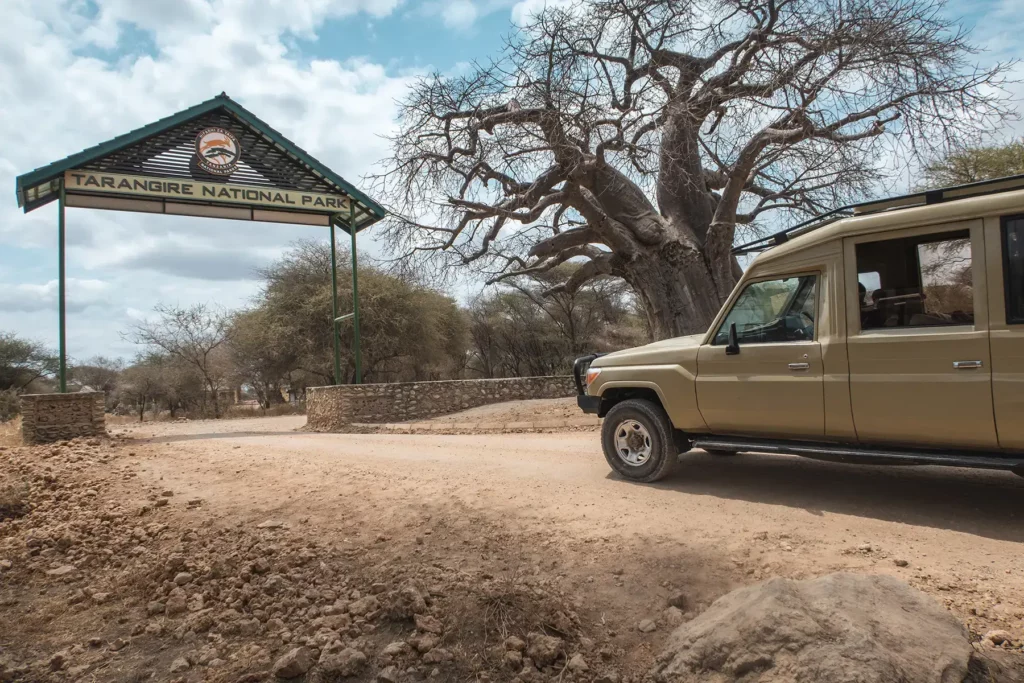
About Tarangire National Park
Tarangire National Park has one of the highest concentrations of elephants in the world, with large herds often spotted amongst the baobab trees. The park is also a haven for bird enthusiasts, with over 550 species.
You can find an abundance of wildlife here, from lions to leopards, giraffes to zebras and plenty more.
The Tarangire River, which runs through the park, is a lifeline for wildlife, especially during the dry season when animals from the surrounding areas head to its banks. This makes it easier to spot wildlife.
Tarangire offers a somewhat underrated safari experience which is why I love to include it in the itinerary!
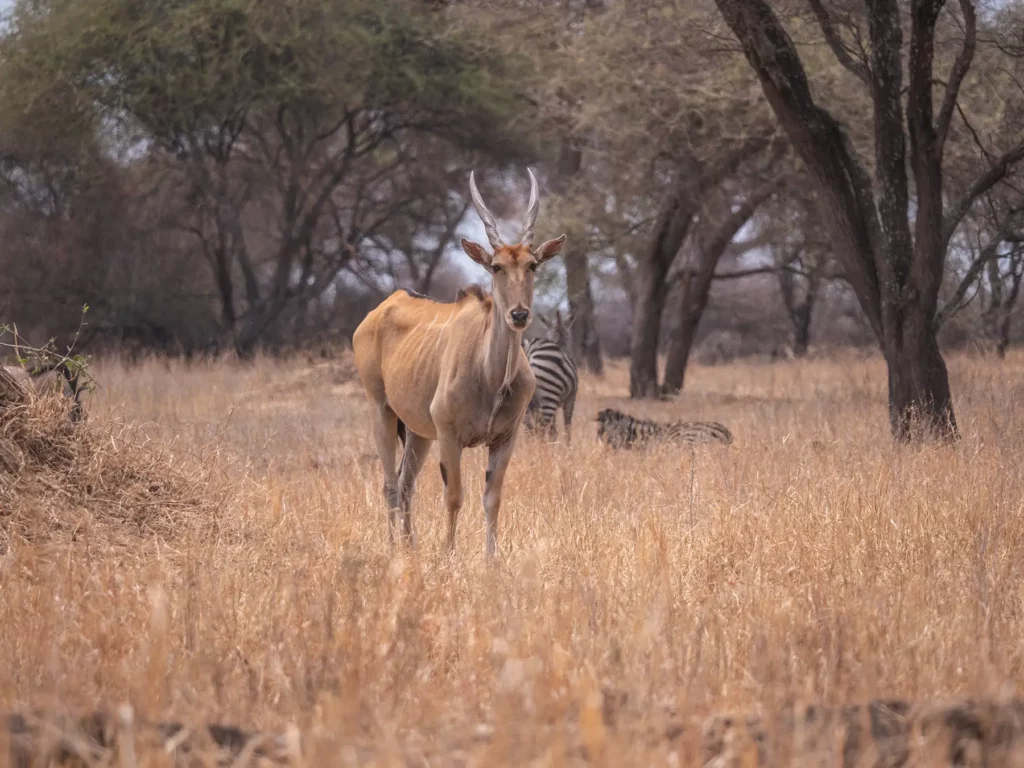
Tips for Visiting Tarangire National Park
It’s best to visit Tarangire in the dry season, between June and October. While you can still have some great wildlife viewing experiences at other times, this is when animals are at their highest density here. You’ll also have the best chance of seeing massive elephant herds. At other times of year the great herds migrate from Tarangire to other areas.
As you’ve probably got used to at this point in your itinerary, it’s best to pack plenty of high-factor sunscreen and insect repellent!
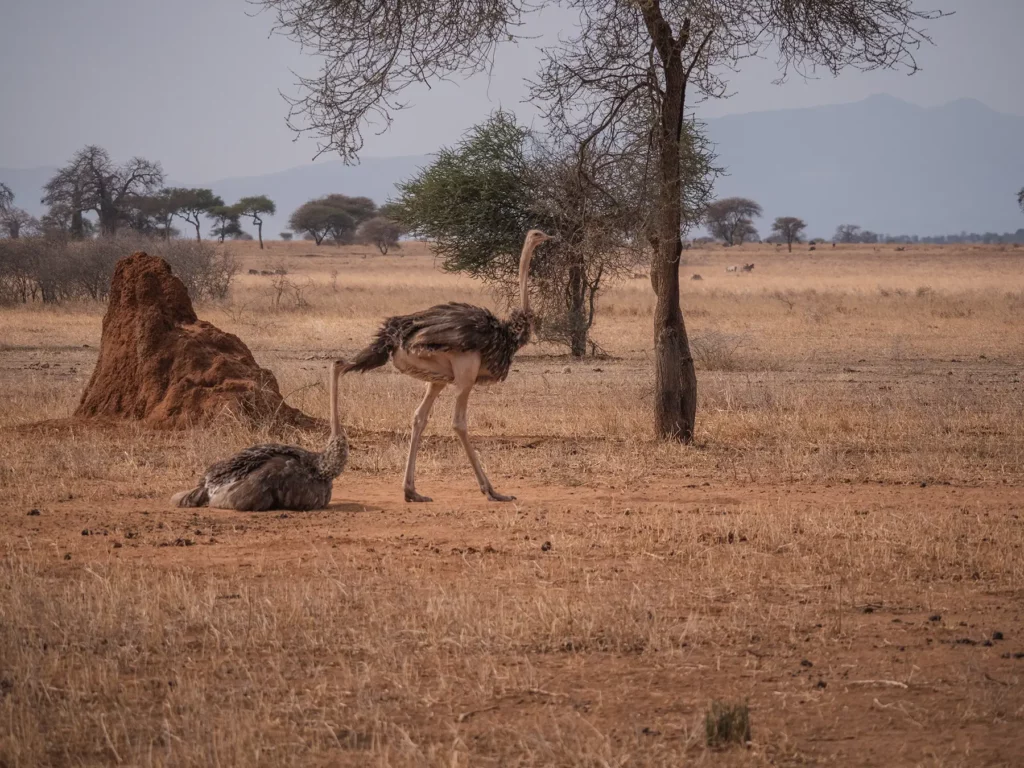
Where to Spend the Night
There are many accommodation options throughout Arusha city, from budget hostels to luxury hotels, so you should be able to find whatever you’re looking for.
If you want to be in the heart of the action, Arusha’s city centre has plenty of options, all offering easy access to shops and restaurants. Staying in the city centre is ideal if you want to spend your final hours exploring Arusha. However, it can be noisier and busier, which might not suit everyone after a busy safari itinerary.
On the outskirts of Arusha, guesthouses provide a quieter, more relaxed atmosphere, often with views of Mount Meru. These accommodations tend to offer more space and greenery, perfect for those who prefer a peaceful retreat after days of adventure. The downside is that you’ll need transport to reach the city’s attractions.
Airbnbs are available throughout Arusha, offering a more authentic home-away-from-home experience. Again, these range from budget choices staying with local families to luxury apartments with glistening city views. Amenities and service levels can vary widely, so it’s important to read reviews carefully.

My Experience Visiting Tarangire National Park
I really loved this park! Everything from the beautiful landscapes and endless elephants makes it a fantastic safari experience. Watching a whole elephant herd cross the road before drinking from the waterhole was wonderful enough, but when the baby started playing in the water I was completely charmed. Soon, they were joined by wildebeest, many birds, and zebras too.
The baboons were also fun to watch, especially seeing the young ones tussling with each other, and a mother carrying a baby on her back. Impalas and baboons hang out and follow each other around here, which I found interesting.
My picnic lunch overlooking the Tarangire River was a fun spot to eat while watching ostriches, zebras, and a few cheeky velvet monkeys who were looking for scraps.
Elsewhere, I saw lions, elands (Africa’s largest antelope), a herd of buffalo, storks, and giraffes. helmeted guinea fowl… and more elephants!
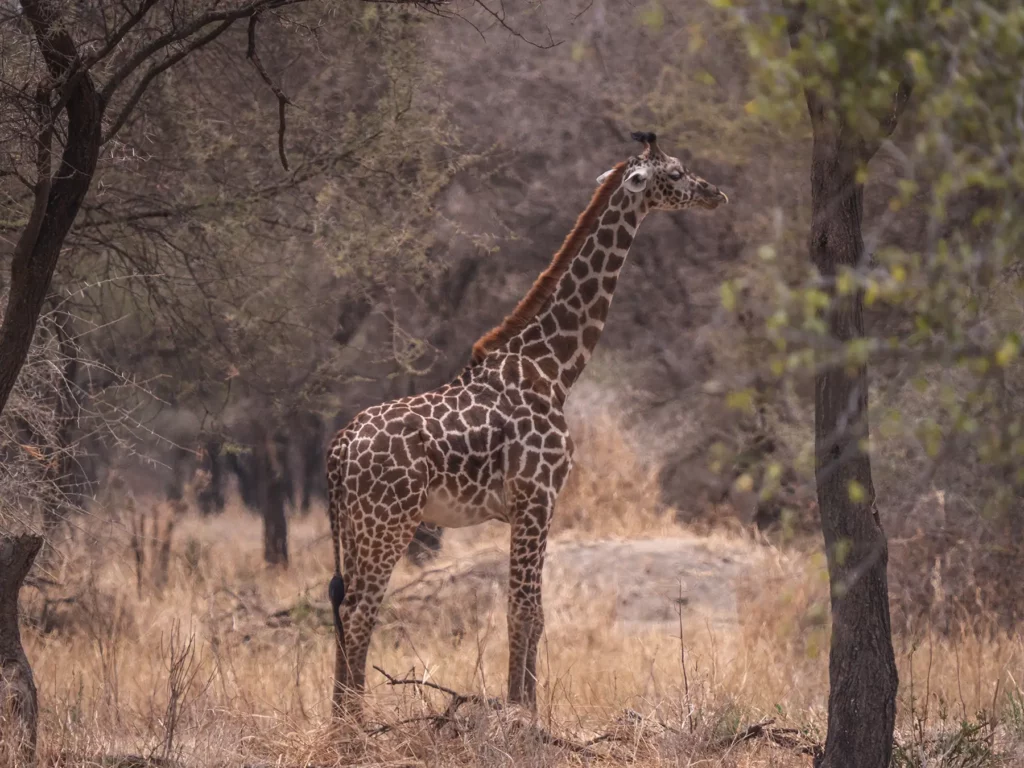
Day 10: Arusha
Total drive time (excluding game drives): dependent on what activities you do
On your last day, you’ll prepare to fly home from Kilimanjaro International Airport.
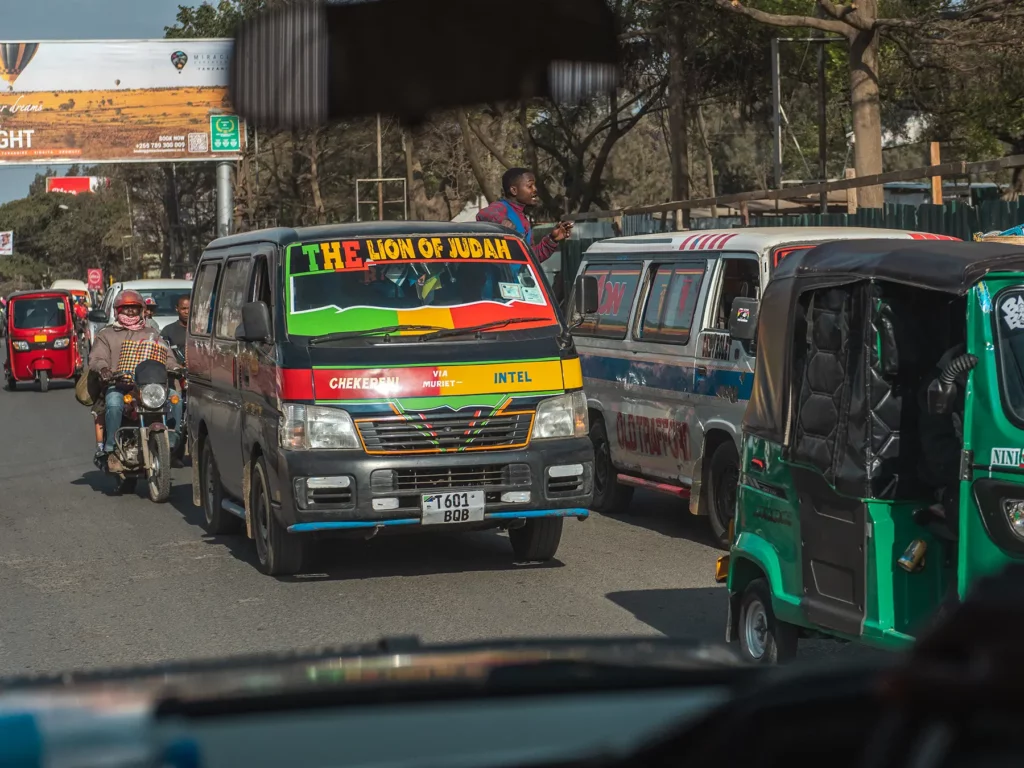
Itinerary
If your flight isn’t until the evening, you have an opportunity to explore the city at the foot of Mount Meru. Arusha is packed with markets, cafes, and cultural sites, offering a glimpse into urban Tanzanian life.
You might spend your morning wandering through the Arusha Central Market, where the stalls burst with fresh produce, textiles, and handmade crafts—a perfect chance to pick up any last-minute souvenirs.
Next, spend lunch at one of Arusha’s garden cafes and taste any local dishes you haven’t tried yet. For a dose of culture, the Cultural Heritage Centre tells the story of East Africa’s heritage.
Leaving Tanzania might be bittersweet, but the experiences you’ve gained on safari are ones you’ll remember forever, and that’s something you’ll always be grateful for!
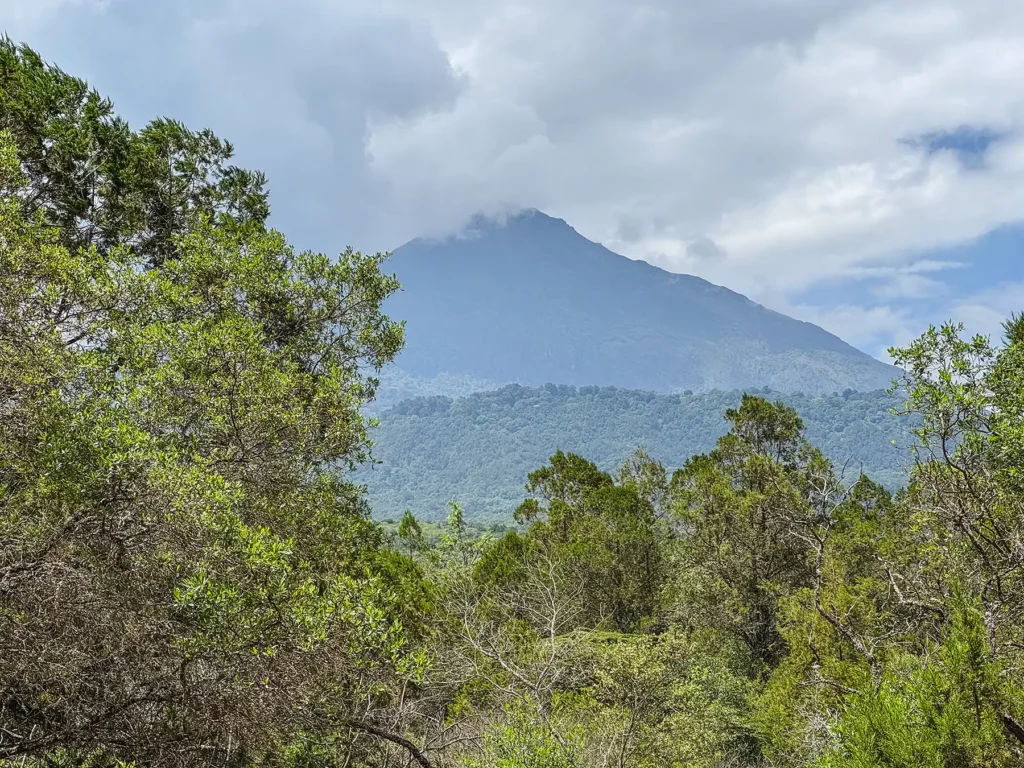
Things to Do in Arusha
Unless you have an early flight (or just want to relax before getting to the airport), there are a few special places in Arusha that are worth visiting if time allows.
1. Chemka Hot Springs
Just a 1-hour drive from the busy streets of Arusha, you’ll find Chemka Hot Springs. More than just a spot to cool off, it’s a natural hot tub nestled in the Tanzanian wilderness – the perfect place for a refreshing dip outside the bustling city and dusty safari trails.
Although beautiful, the journey to the springs is an adventure in itself, so might not be the best option if you just want a quick and easy attraction before your flight. That said, the roadside views over Tanzania’s landscape and village will have you glued to your seat.
At Chemka Hot Springs you can swim through the cyan waters, visit the ‘food spa’ where tiny fish nibble the dead skin from your feet or use a rope swing to leap into the waters. This is honestly my favourite thing to do in Arusha!

2. Arusha National Park
Missing game drives already?
While it might not be as famous as other national parks you’ve visited, Arusha National Park still boasts a good number of zebras, buffaloes, and giraffes, and even offers the opportunity to spot predators like hyenas and leopards. You might also catch a glimpse of hippos and elephants.

You have the choice between a driving safari, or mix things up with a more budget-friendly walking safari, or even canoeing on Lake Momella. Arusha National Park is one of the few parks in Tanzania where you can go on a walking safari as large predators like lions and leopards aren’t present here.
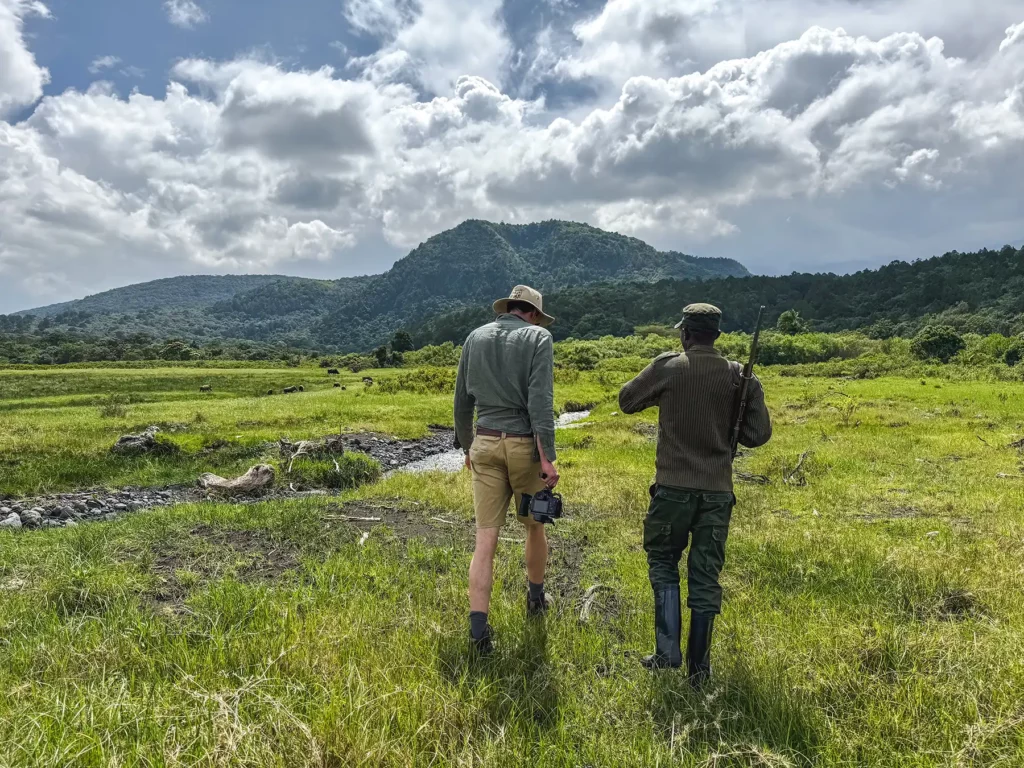
3. The Maasai Market
Need an authentic souvenir or gift to take home with you? Visitors to the market can expect to find a selection of items, including beaded jewellery, woven baskets, textiles, and Masai blankets, each showcasing the craftsmanship of the local Maasai community.
Visiting this market contributes to the preservation of traditional Masai culture and gives you a great opportunity to engage with locals.
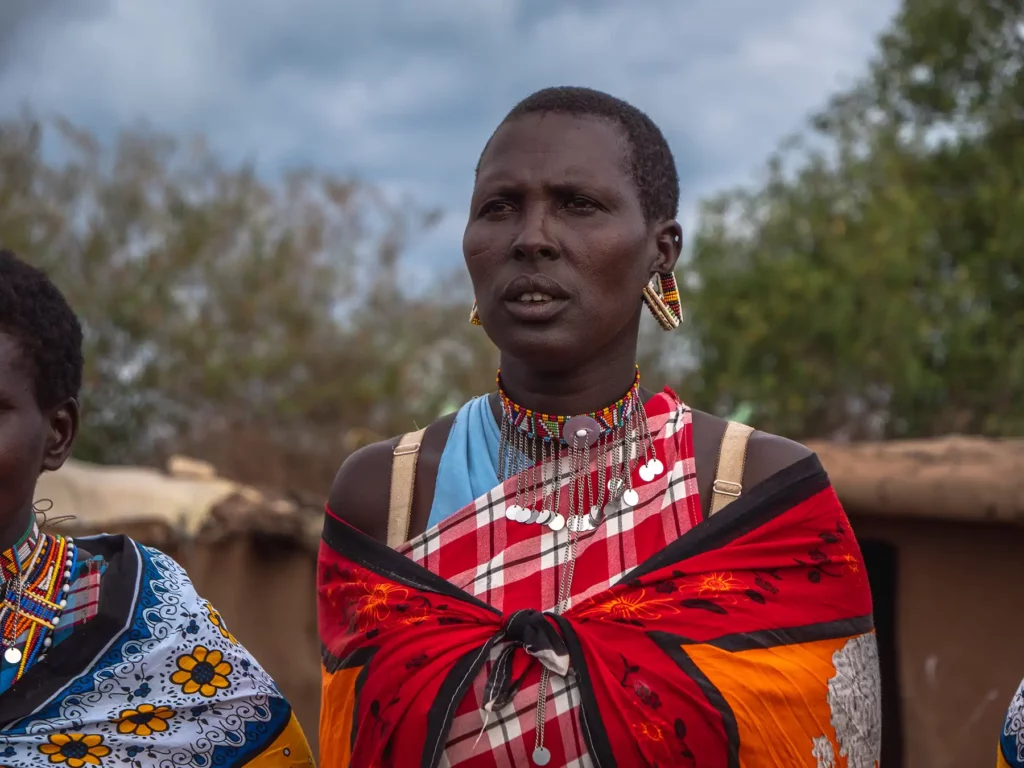
4. Dine at a Local Restaurant
Arusha’s food scene is varied, to say the least. If you’re keen on trying some local flavours, Khan’s BBQ is the place to go for their famous chicken tikka. Alternatively, there’s the Blue Heron Restaurant, nestled in a gorgeous garden, serving up a blend of international and Tanzanian meals.
Recommended Booking Options For Your 10-Day Kenya and Tanzania Safari Itinerary
Private Safari
Most popular & best experience – typical prices for this itinerary start from $300 per person per day.
Visit safarisbyella.com for free quotes from trustworthy local tour companies I use to book my own trips.
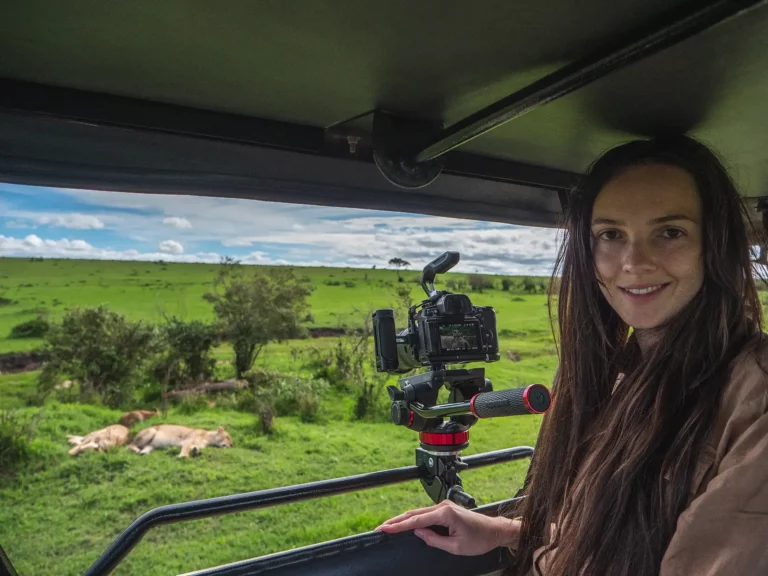
Group (Shared) Safari – Usually Camping
Good for budget or solo travellers – from $200 per person per day.
My recommended Tanzania tour operators only provide private safaris, however, I’ve listed the best and most similar group options for this itinerary, on SafariBookings below.
Click the link below to request quotes for the group safari options on the SafariBookings website.
11-Day Kenya and Tanzania Group Budget Safari (Option 1)
11-Day Kenya and Tanzania Group Budget Safari (Option 2)
12-Day Kenya and Tanzania Group Budget Safari
View All My Recommended Group Options Following a Similar Itinerary
Final Thoughts
When it comes to having a fantastic African safari, you really can’t do better than Kenya and Tanzania. Both countries are right next to each other and similar in cost, while still each having something unique to offer. Combining the two countries into one epic safari itinerary just makes sense.
This 10-day itinerary is all about getting straight into each country’s highlights. Starting with Masai Mara and the Serengeti, you’ll dive straight into two of the most world-renowned safari parks on the planet. Visiting just one of these epic destinations deserves a place on any bucket list – seeing both is the trip of a lifetime!
And by adding Ngorongoro Crater and Tarangire National Park into the mix, you’ll be able to see another side of East Africa in a short time, with a wonderful focus on the region’s diverse wildlife and landscapes.
I hope this guide has helped you plan your dream safari trip and can’t wait for you to experience it all for yourself!
Read More Tanzania Guides
For an overview of planning your safari, you can read my Ultimate Tanzania Safari Guide.
Tanzania Itineraries
Recomended itineraries and how to book them.
7-10 Day Tanzania Safari Itinerary & Costs
5-Day Tanzania Safari Itineraries & Costs (6 unique Itineraries)
3-Day Tanzania Safari Itinerary & Costs
2-Week Tanzania & Zanzibar Safari Itinerary & Costs
3-Week Tanzania Safari Itinerary & Costs
10-Day Tanzania Honeymoon Itinerary & Costs
Tanzania and Kenya Itineraries
Multi-country itineraries and how to book them.
10-Day Kenya and Tanzania Safari Itinerary
2-Week Kenya & Tanzania Safari Itinerary
Costs & Planning
How to get the most bang for your buck and the best time of year to visit depending on what you want to do and see.
Tanzania Safari Cost – Everything You Need to Know!
The Great Wildebeest Migration Guide
Zanzibar Island – The Complete Guide
National Parks & Reserves
Complete guides to the best and most famous safari reserves, including the wildlife you’ll see, entrance costs and best time to visit.
Other Popular Safari Destinations
How to Book Your Safari
Save time and ensure an incredible safari experience by getting quotes from my recommended local safari companies.
Join the rapidly growing tribe of over 1,000 travellers who’ve booked their dream safari using my insider tips and recommendations.
Read More Kenya Guides
Kenya Itineraries
Recomended itineraries and how to book them.
7-10-Day Kenya Safari Itinerary
3 Day Kenya Safari Itinerary & Costs
2-Week Kenya Safari Itinerary & Costs
Kenya & Tanzania Itineraries
Multi-country itineraries and how to book them.
10-Day Kenya and Tanzania Safari Itinerary
2-Week Kenya & Tanzania Safari Itinerary
Costs & Planning
How to get the most bang for your buck and the best time of year to visit depending on what you want to do and see.
Kenya Safari Costs – Everything you Need to Know
The Great Wildebeest Migration Guide
National Parks & Reserves
Complete guides to the best and most famous safari reserves, including the wildlife you’ll see, entrance costs and best time to visit.
Coming soon.
Other Popular Safari Destinations
How to Book Your Safari
Save time and ensure an incredible safari experience by getting quotes from my recommended local safari companies.
Join the rapidly growing tribe of over 1,000 travellers who’ve booked their dream safari using my insider tips and recommendations.
